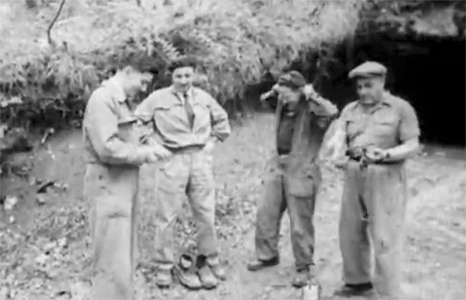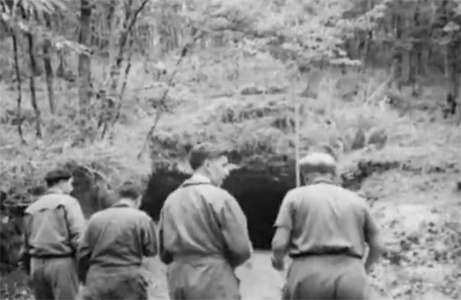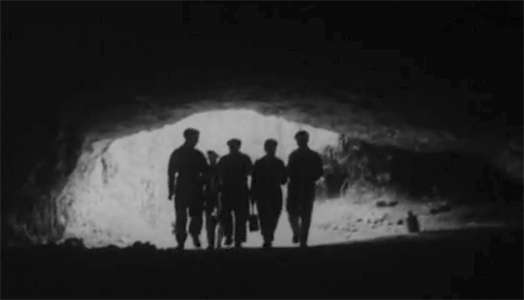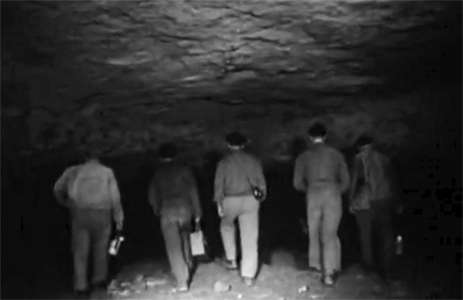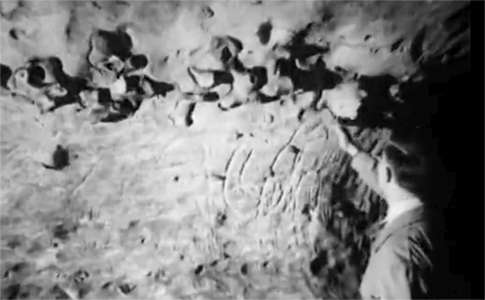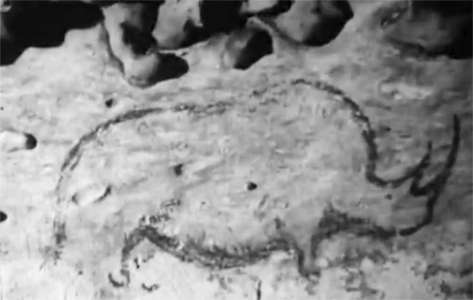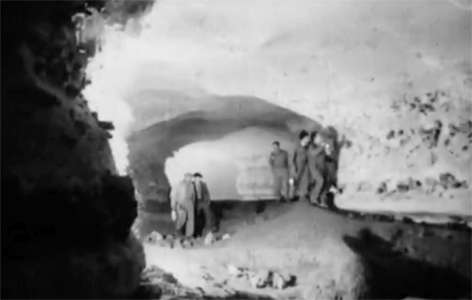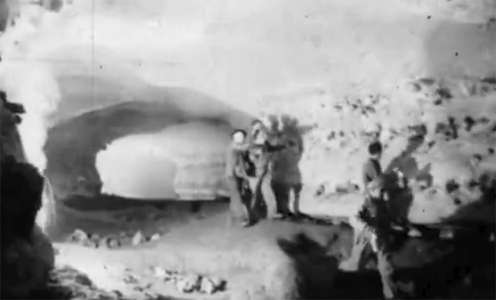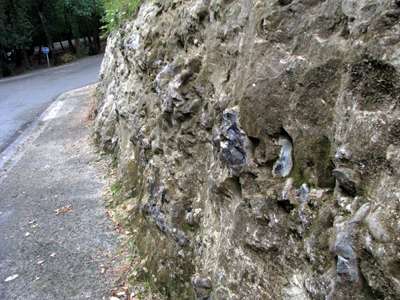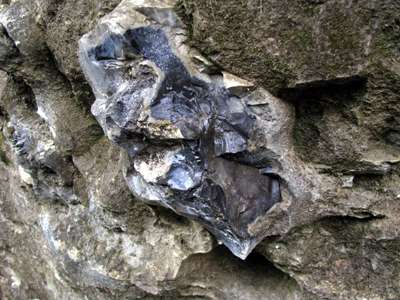Rouffignac Cave - La Grotte de Rouffignac, ice age art
The cave of Rouffignac, La Grotte de Rouffignac, containing ice age art has been known for centuries and was described in 1575 by Francois de Belleforest. It is located in the heart of the Perigord, between Bergerac and Sarlat in the Dordogne region. The site has more than 250 etchings, line drawings and cave paintings dating from the Upper Paleolithic (Magdalenian, more than 13 000 years BP). With a length of over eight kilometres, this cave is one of the largest painted caves in Europe.Visitors use an electric railway to gain access to the cave. Research has identified numerous traces of claws and lairs left by the cave bear before human intervention. These galleries were decorated with 158 mammoths associated with woolly rhinoceroses, bison, horses and ibex. The figures are deeply engraved or painted black. Tectiform signs and four human figures are also present.
Text above translated from the French version of Wikipedia.
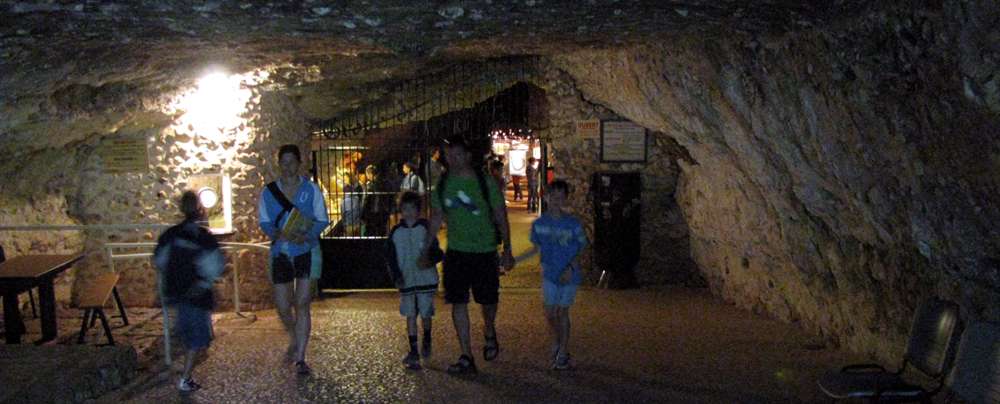
La Grotte de Rouffignac is set up very well for the tourist trade, yet manages to preserve the original feeling of the cave during the actual visit, paradoxically by the use of an electric train.
Photo: Don Hitchcock 2008
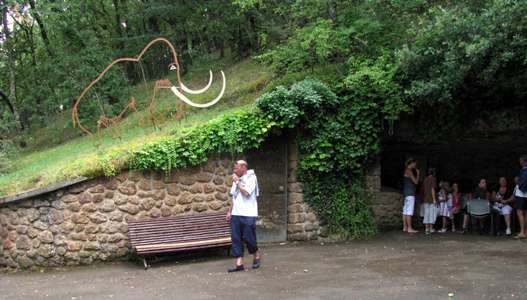
The cave is an extremely popular tourist destination, and has been set up in a very professional manner. Casual visitors such as myself usually have to wait for several hours to get in.
Photo: Don Hitchcock 2008
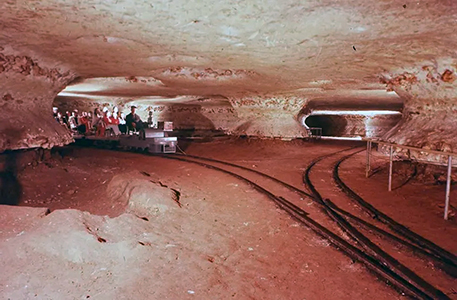
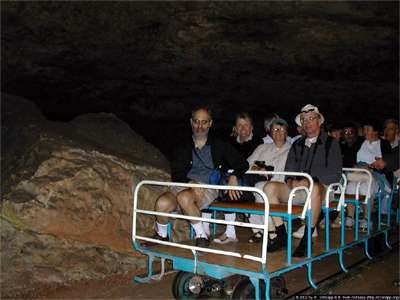
The electric train seats 32 people, and although there are two trains, nevertheless there are more customers than can easily be accommodated during the peak tourist season. I was there in August.
Photo: (left)
https://www.francebleu.fr/infos/societe/dordogne-les-touristes-plebiscitent-les-grottes-pour-echapper-a-la-chaleur-156157409
Photo: (right) ©2002 by R. Schnapp et B. Hom-Schnapp, http://www.schnapp.org/VF2002/20020920.html
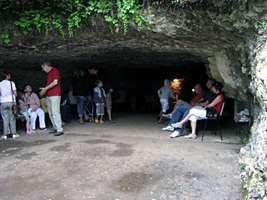
There are places to wait outside the cave until your visit is scheduled, but many must go elsewhere to fill in time. Bring a good book!
Photo: Don Hitchcock 2008
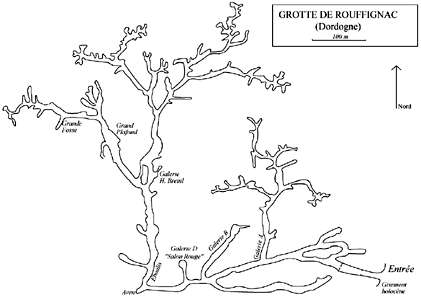
Plan of the Rouffignac Cave..
Photo: http://www.grottederouffignac.fr/cadreFR.asp
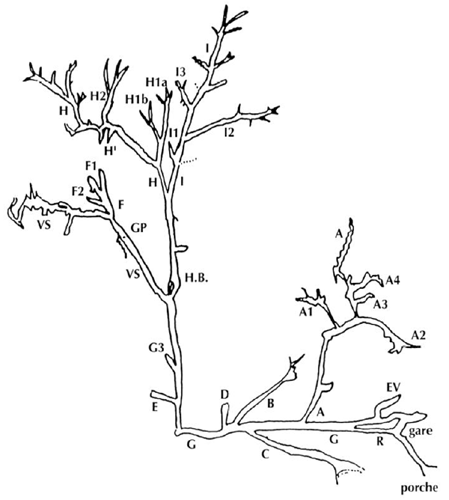
Plan of Rouffignac Cave as drawn by Claude Barrière showing the standard nomenclature of the galleries.
Photo: Plassard et Plassard (2000)
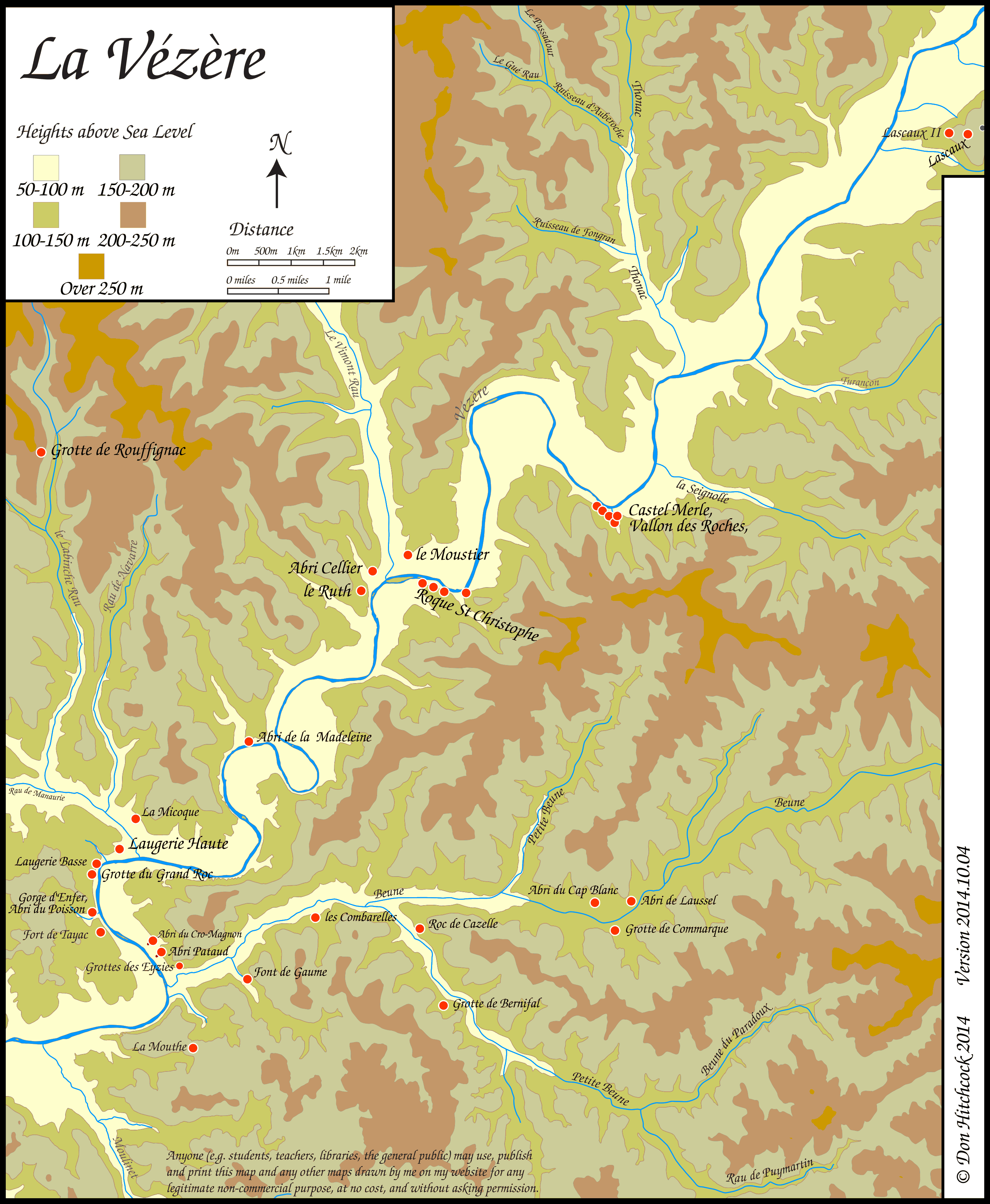
Map of sites in the Vézère Valley of France, including la grotte de Rouffignac.
If you click on the map you will see a larger map with the ability to click on the marked sites and get further information.
Photo: Don Hitchcock
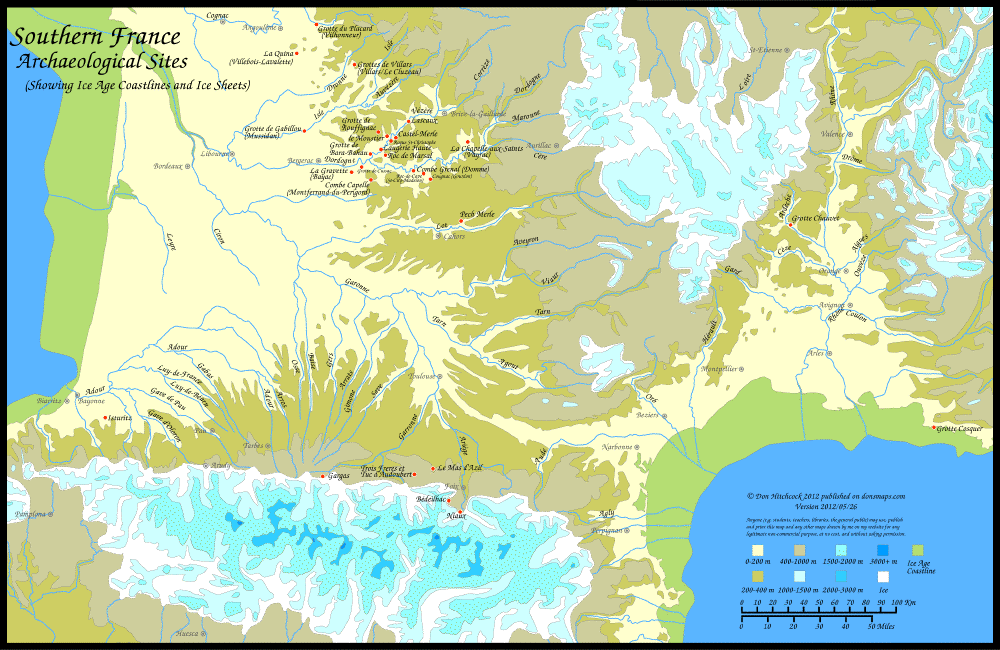
Note - Use this pdf file if you wish to print this map on a single sheet of paper.
Photo: Don Hitchcock version 2012/05/26
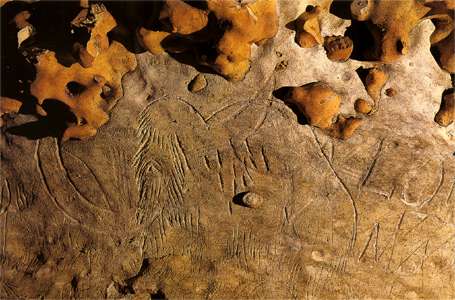
Mammoth Engraving, known as the Patriarch.
Photo: Postcard © Editions Rene.
An analysis of the Grand Ceiling of Rouffignac by Professor Leroi-Gourhan.
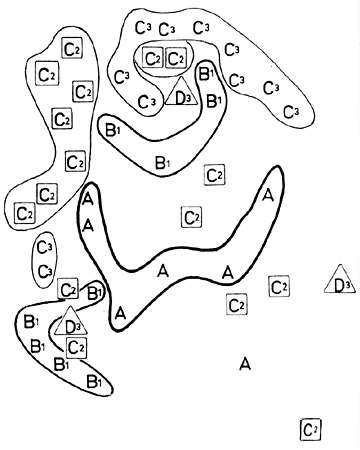
(This analysis has been investigated by Barrière (1980) (see below) and an alternative schema has been proposed to the one shown here - Don)
Leroi-Gourhan's diagram of the grand painted ceiling at Rouffignac, showing the grouping of species and thus also the central and peripheral figures.
A - Horse
B1 - Bison
C2 - Mammoth
C3 - Ibex
D3 - Rhinoceros
Photo:
Sieveking (1979)
The Grand Ceiling of Rouffignac - Le Grand Plafond de Rouffignac
This is a very important paper by Claude Barrière which deserves a much wider audience. Few of the visitors to Rouffignac would realise that the level surface they stand on to view the wonderful Grand Ceiling was once only one metre above a cavernous hole in the ground, seven metres deep, with slippery clay sides leading to a river in the depths below - and that the original artists put it there on purpose, when there were plenty of ceilings much more easily accessible on either side of the hole.
Barrière, C., 1980: Le Grand Plafond de Rouffignac, Bulletin de la Société préhistorique française. 1980, tome 77, No.9. pp. 269-276
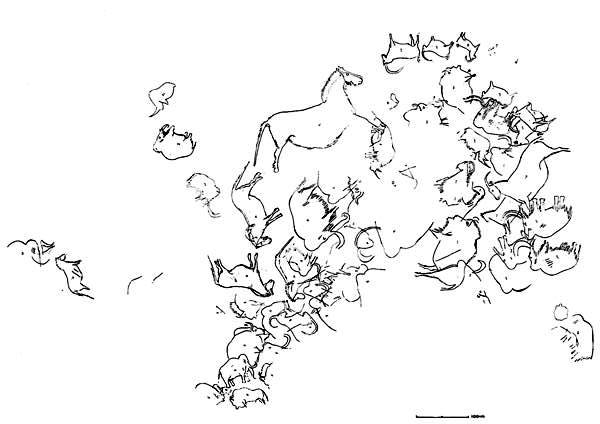
The Grand Ceiling of Rouffignac.
In the main gallery called by L. R. Nougier and R. Robert the Sacred Way, because of its wealth of parietal art, about 700 metres from the entrance, there is an area specially remarkable for the abundance of figures pictured on the ceiling.
The Sacred Way, already vast, expands a bit more and develops a vast, perfectly flat canopy, then it begins to shrink at the same time as the gallery bends slightly to the left.
At this point, there was a gaping open pit at the bottom of a huge funnel of clay whose opening, before the work of tourism development, occupied the entire width of the gallery.
The Grand Ceiling ensemble is the most significant area of paintings and engravings in the entire cave, as it concentrates 66 figures at the one place.
Photo and (translated) text: Barrière (1980)
The presence of these designs over this broad funnel leading to a slippery clay pit of 7 metres depth, of which at least 4 m was vertical, posed significant problems.
The first problem was accessibility. On the whole circumference of the funnel, the ceiling height was very low: it rarely exceeds a metre and, given the slippery slope, this highlights the difficulties in the drawing of many of the figures and particularly the largest, the great horse, which is in excess 2 metres in length.
On the other hand, some animals are not accessible for an artist trying to stand on the steep slope of the funnel.
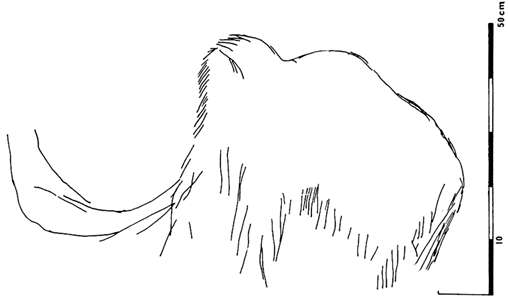
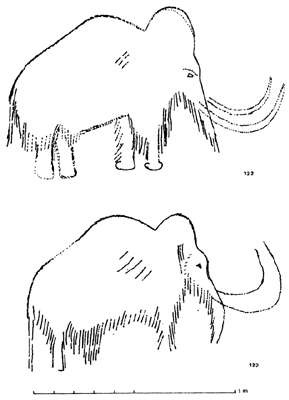
(left) Mammoth 65, engraved
(right) Mammoths 122 and 123
Photo: Barrière (1980)
The funnel or well existed at the time of the paintings. The artist used a scaffold of which a few small impressions were still visible on the inside edge, which had not been trampled by visitors and the inevitable destruction of tourism development.
The marks of squared timber and human fingerprints strongly mark the edge of funnel. This is not surprising. Impressions of scaffolding were discovered in the Axial Gallery of Lascaux. (Barrière et al, 1964)
(The Diverticule Axial de Lascaux paintings are too high to have been painted without artificial help. Holes in the wall containing the remains of oak joists show that a raised floor or scaffolding was constructed in order to make the paintings there - Don, from http://www.hominides.com/html/lieux/grotte_lascaux.php)
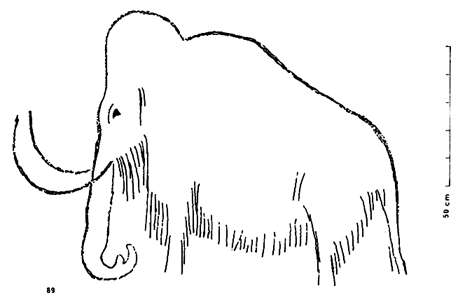
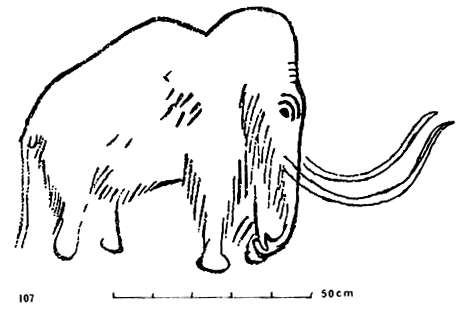
(left) Mammoth 89
(right) Mammoth 107, known as "Grandfather".
Photo: Barrière (1980)
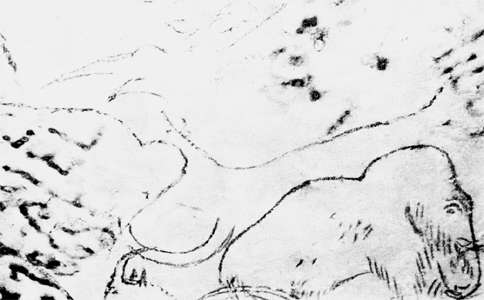
Ceiling panel of figures drawn in black in the vicinity of the well, where we see: a Rhinoceros upside down, two mammoths in line, (the one in front is Mammoth 107, "Grandfather") and part of the figure of an Ibex. On the left, an inscription in soot, from 1863, of which the carbon, in impalpable particles, has started to be absorbed in the air: Professor Moissan reported this phenomenon to Dr. Capitan at the beginning of the century, to explain the disappearance, more or less rapid, of traces of soot in the painted caves.
Photo and (translated) text: Breuil (1959)
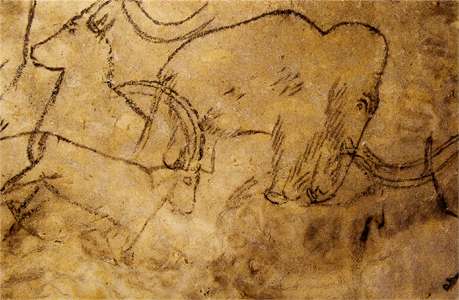
Mammoth (Le Grand-Père) and Ibex on the Grand Plafond.
Photo: Postcard © Editions Rene.
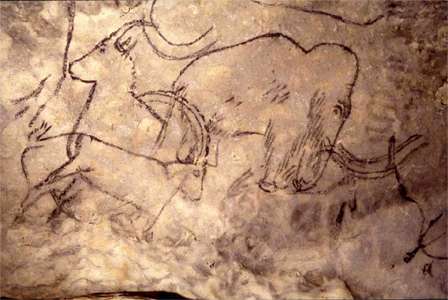
Another version of the mammoth (Le Grand-Père) and Ibex on the Grand Plafond.
Photo: ©Jean Plassard, owner, Grotte de Rouffignac.
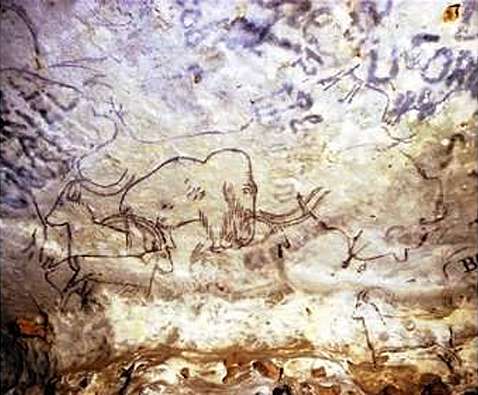
Detail of the ceiling: Le Grand-Père.
Photo: http://nicole.rolin.pagesperso-orange.fr/prehistoire/Pages/La%20grotte%20de%20Rouffignac.htm
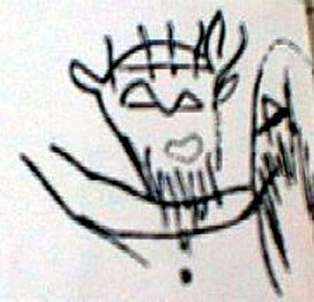
Bearded anthropomorphic figure. Images of humans are very rare in the Palaeolithic.
Photo: http://nicole.rolin.pagesperso-orange.fr/prehistoire/Pages/La%20grotte%20de%20Rouffignac.htm
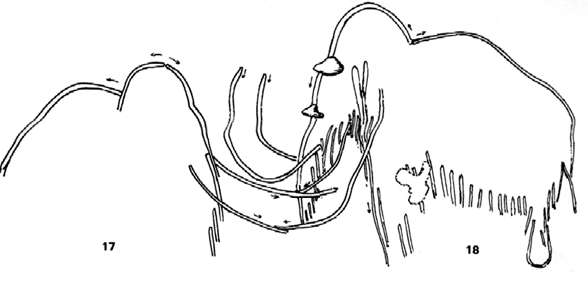
Two mammoths created as finger drawings in soft clay. Note the directions of the strokes indicated on the image.
Photo: http://nicole.rolin.pagesperso-orange.fr/prehistoire/Pages/La%20grotte%20de%20Rouffignac.htm
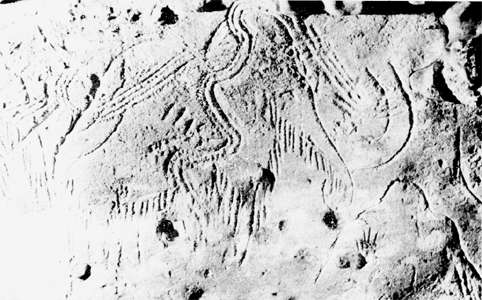
Engraved Mammoth, deeply overlaid by serpentine coils, on the middle wall on the right of the western gallery, in a part where condensation did not affect the artwork, the cold air not succeeding in causing condensation because of the ground rising gradually towards the well.
Photo and (translated) text: Breuil (1959)
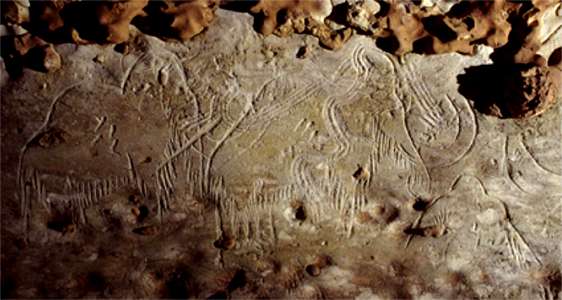
A modern photo of the engraved mammoth above, overlaid by serpentine coils.
It occurs on the left side of the frieze of the 5 mammoths of the Sacred Way. M43 (L = 85 cm), M44 (L = 85 cm) and M45 (L = 45 cm).
Photo: Jean Plassard, Igarashi (2010)
The second problem is the choice of this location. There was plenty of choice. Before and after the Grand Ceiling, the gallery offers a large ceiling-like surface with the same qualities of flatness or rock, with much better access, but there are no paintings or engravings there.
Rouffignac Man voluntarily chose this spot and despite the difficulties inherent in the presence of the well that gives access to the second floor, there are also figures placed just above the opening giving access to the third floor, where the creek flows in the depths below.
Here is a set of facts that form the basis of the organisation of all of the art of the cave and give, in our opinion, the key to a possible meaning of Rouffignac. But we will not pursue that topic here.
Almost all of the figures are drawn in black, but there are some engravings and figures in mixed media, specifically:
An engraved mammoth.
An engraved horse without a head.
An engraved top of a mammoth head.
A Mammoth half drawn, half engraved.
A Bison half drawn, half engraved.
The inventory of the figures of the Grand Ceiling is as follows:
26 mammoths, 12 bison, 11 Horses. 12 Ibex, 3 Rhinoceros, an eye, one indeterminable (probably an ibex).
A total of 66 figures.
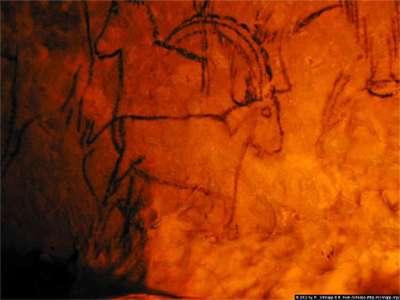
Ibex, on the Grand Plafond at Rouffignac.
Photo: http://www.schnapp.org/VF2002/images/LowQ/20020920_14.jpg
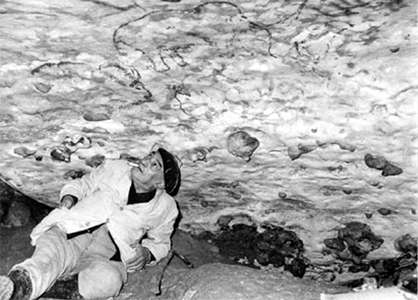
Henri Breuil at the Grand Plafond. Note the low ceiling. H. Breuil is at one edge of the deep well above which the Grand Plafond was created.
Photo: http://www.grottederouffignac.fr/expo2006-2007.asp
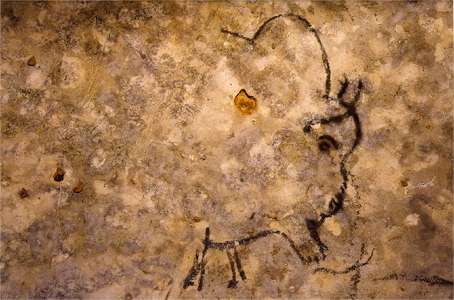
Painting of a Bison on the Grand Plafond.
Photo: Postcard © Editions Rene.
Organisation of the Grand Ceiling.
At the outset, the Grand Ceiling can be seen to be a unique part of the area called the Sacred Way. While the figures elsewhere are usually isolated or aligned in friezes on the walls and ceilings, here is an important set of figures, the largest in number, 66, in an apparently chaotic swirling pattern, in a particular topographical situation, that is, over a large funnel leading to a suction pit giving access to the second floor of the cave, a difficulty which is nonexistent a few metres before or after. The accessibility of certain parts of the ceiling has been possible only through the use of timber with squared ends laid across the hole.
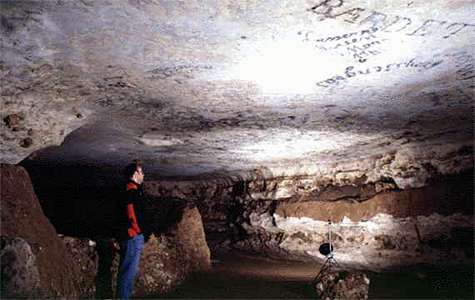
The Grand Plafond, with the well filled in, and the sides excavated to put the ceiling at a reasonable height for modern visitors.
Photo: http://www.culture.gouv.fr/culture/conservation/fr/grottes/Pageshtm/3-1.htm
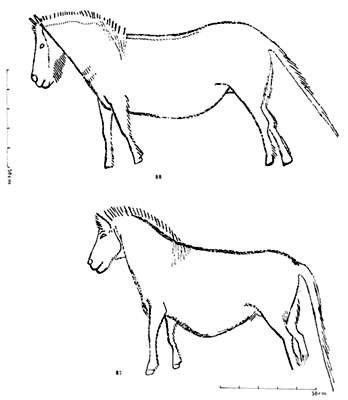
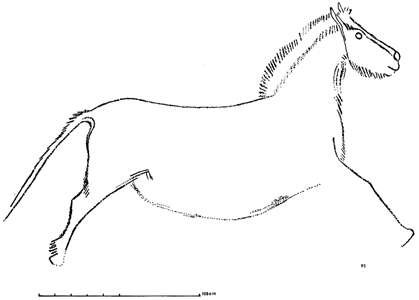
(left) Horses 88 and 87
(right) Le Grand Cheval, horse number 95.
Photo: Barrière (1980)
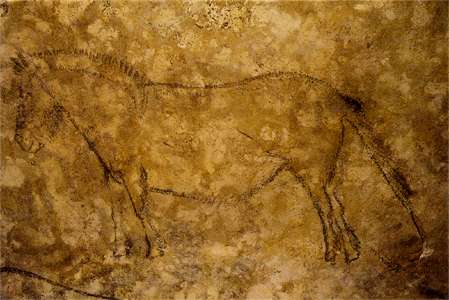
Horse 88 in colour, as it appears on the Grand Plafond. This is a superb painting, showing very accurate observation of the animal, from an artist who knew his subject well.
Photo: Postcard © Editions Rene.
(I wonder if the ends were squared so that the poles did not roll when pressure was applied while the painter was using them as a support? Perhaps the entire pole was squared, or at least flattened on top, as well, to make it more comfortable to lie or squat on, and paint the ceiling, little more than a metre above the painter? If I were to build such a scaffolding, I would dig out the side of the clay pit at each place for a pole, and bed in a large flat stone there as a secure footing for the squared off ends of the poles - Don)
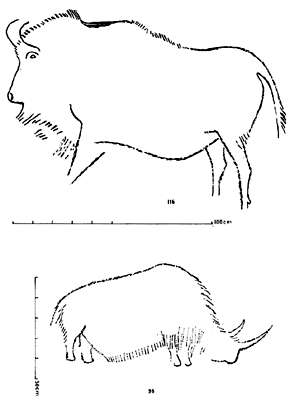
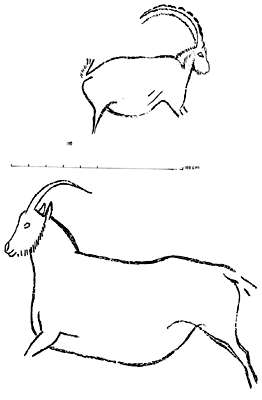
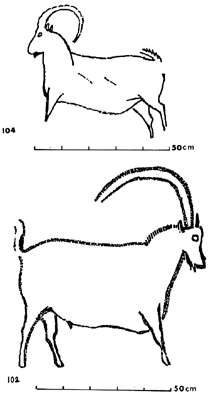
(left) Large Bison 116, Rhinoceros 96
(centre) Ibex 110, Large Ibex 112
(right) Ibex 104, Ibex 102
Photo: Barrière (1980)
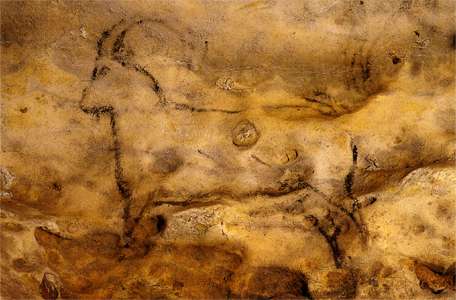
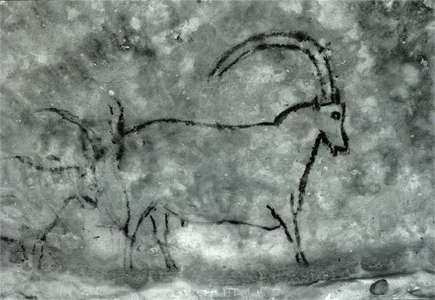
(left) Ibex 104 on the Grand Plafond.
(right) Ibex 102 on the Grand Plafond.
Photo: Postcard © Editions Rene.
The originality, the uniqueness, of this Grand Ceiling increases if one considers the bestiary. Of course, here we find the ubiquitous mammoth, the rhinoceros, bison and horses, but:
- The drawings are often the largest and finest specimens of the cave, or more numerous: 11 out of 14 horses are here, with the largest and best painted specimens, as well as half the Bisons, including the largest.
- And especially the Great Ceiling accounts for all the ibex, which are absent from the rest of the cave. This fact alone highlights the particular character of the bestiary.
One can further understand the quality of these figures by noting that they were executed not only from uneven ground, with the artist always in danger of sliding into a well, but mostly located on a ceiling which is little more than one metre high; yet even so, the artists who executed the drawings were somehow able to draw sometimes quite large designs (270 cm for the Great Horse, the great Mammoth 140 cm, 150 cm for the Ibex, the Bison 155 cm), without any distortion in the correct proportions.
At first glance, to an inattentive visitor, this bestiary appears to be, especially in the current conditions of degradation and modern smudging, in a disorderly arrangement, with animals in all directions, more or less intertwined and superimposed.
In fact, surveys show a disposition of the images in a semicircle around the shaft. The overall ceiling can not be understood at a glance because of the lack of perspective: in fact, it is from the bottom of the well that one must see the Great Ceiling.
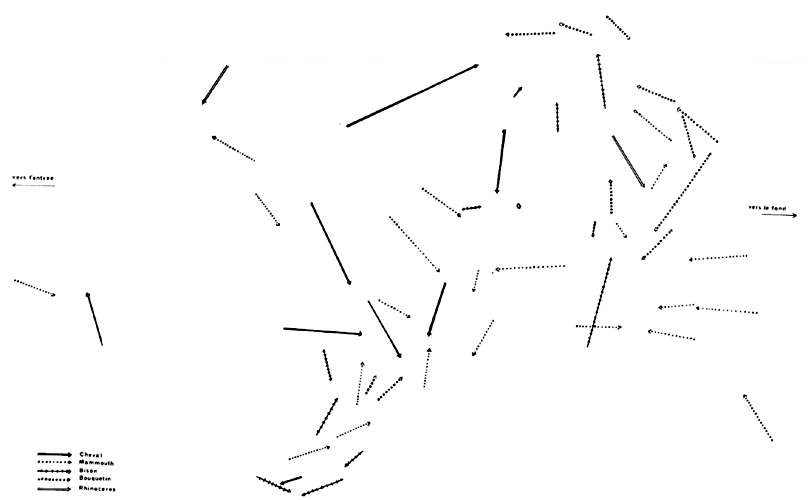
To better understand the composition of this set, we must use the following artifice: replacement of the animals by different arrows for each species and the length of each animal.
Immediately the disorder disappears, and the animals are arranged in a very particular pattern, the whole is organised according to an Omega shaped plan of accessibility of the ceiling around the well.
Photo: Barrière (1980)
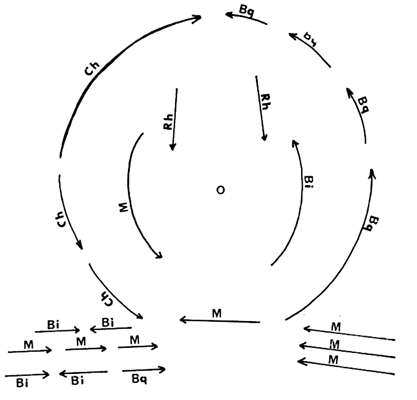
A circle (opening above the well) appears composed:
- Of a half-circle composed entirely of Horses
- Of a half-circle composed entirely of Ibex
The half circle of horses is divided into two segments of opposite directions,
The semicircle of horses is broken into two segments of opposite direction, one going to the well consisting of several small horses, the other one large horse.
The semicircle of ibex also decomposes into two segments of opposite direction, one going to the wells, of several small Ibex, the other one lone large Ibex.
Photo: Barrière (1980)
The arrangement is reversed for the two species. It follows an arrangement of opposite sizes and opposite directions.
Inside this circle, other animals of different species are distributed in the following way, also arranged as a semi-circle, but less clear:
Compared to Horses, the Mammoth dominates by number (ten times the number of Horses and Bison) and size (large Mammoth). The Great Mammoth corresponds to small horses and goes in the same direction, only one small Mammoth corresponds to the large horse.
Compared to ibex, bison dominate mainly by size: the great bison here corresponding to the large ibex but in the reverse direction, which is in every sense the opposite of the mammoths.
Going more to the centre, the two rhinoceroses, one on each side, in the same direction, on the largest side the great horse, on the smallest side the small Ibex.
The centre of this set is empty of animals, with, however, almost at the geometric centre, an almond shaped design looking exactly like a large eye.
This set is complemented by:
Coming from the far end of the cave (thus towards the entrance), a group composed solely of mammoths, and joining the ends of the semicircles a large Ibex and a large Bison.
- Coming from the entrance of the cave, there is a complex group of bison (either entering or leaving), dominant by number and size, and Mammoths (all entering).
This Scheme is not, in fact, totally correct.
Some figures do not conform to this plan. But then, we should note that it is most often only parts of animals which we see: simple sketches of the back of a Mammoth, the nose of a Horse, as if the artist, realising his mistake, abandoned his design.
Five figures are in the gap of this composition: three mammoths, a horse and a rhinoceros (in quite different styles), pointed to the exit in inconsistent directions.
Note:
This has not taken into account that some of the figures have feet pointing to the inside of the circle and others outward: this is the result of a flat projection on a half spherical surface. In fact, at the site, the observer sees the animals standing on their feet.
This disposition in half or quarter circles with alternating directions sometimes leads to confrontational positions, head to head. These are perhaps the mere consequence of the device, without being conscious and meaningful. However, note that all three cases of confrontation apply only to the Bisons, as the group that entered the inner circle in groups where there are dominant Bison, either by number or by size.
Finally, it follows from this general scheme that the animals are in groups, sometimes going to the well, sometimes leaving the well.
It might be considered that this organisation of the Grand Ceiling may be the result of chance or just the simple disposition of artwork on the periphery of the well.
However the alternations and distributions are too systematic not to conclude that they the arrangement was purposeful. The Grand Plafond is a composition involving a prior design, but which does not completely rule out contributions more or less spontaneous and anarchic, either before or after the execution, or execution errors that alter slightly the scheme of the director of the exercise.
Le Grand Plafond de Rouffignac, even if its meaning or details of its organisation may give rise to debate, is indisputable evidence that some prehistoric caves give rise to a thematic organisation based on the idea but not on the scheme proposed by Professor Leroi-Gourhan.
Text: Barrière (1980)

Line of rhinoceros, painted in single file. Each figure measures approximately 100 cm long.
Photo:
Sieveking (1979)

Line of rhinoceros, painted in single file. Each figure measures approximately 100 cm long.
Photo: Postcard © Editions Rene.
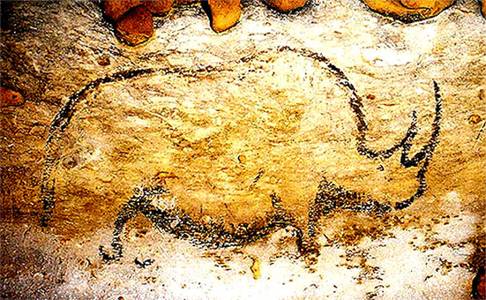
The first in line of the rhinoceros above in close up.
Photo: http://leseyzies-tourist.info/dordogne-caves-and-shelters/cave-of-rouffignac
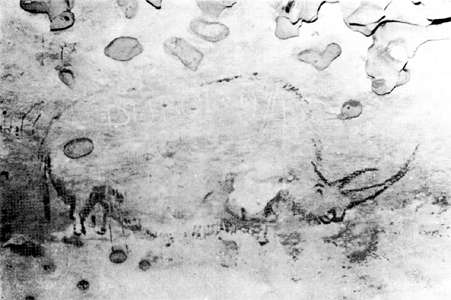
The middle of the three rhinoceros, executed in black manganese dioxide on the clean area of the concavity underlying the upper level with pebbles of flint. It is only marred behind his short legs and the centre of his belly, by the condensation zone which has degraded the image a little. Right side of the western gallery.
Photographer: Romain Robert
Photo and (translated) text: Breuil (1959)
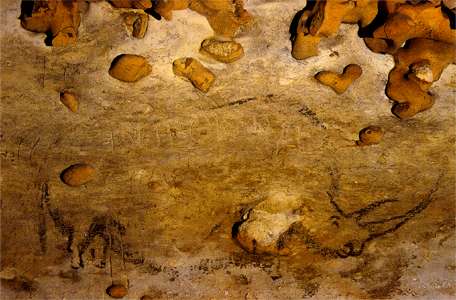
This is the middle of the three rhinoceros above, in colour. In this excellent photograph we can see the figure more clearly.
Photo: Postcard © Editions Rene.
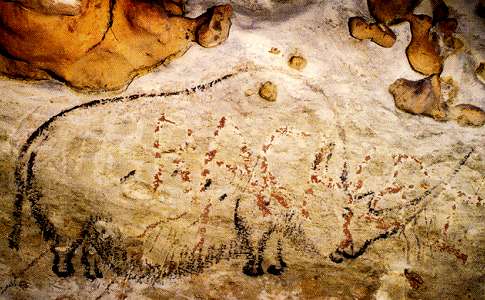
This is the last in line of the three rhinoceros above, in colour.
Photo: Postcard © Editions Rene.
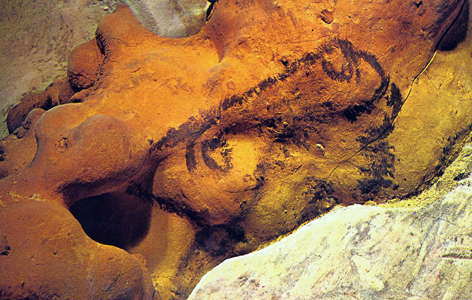
Horse head, looking up to the right.
Photo: Unknown
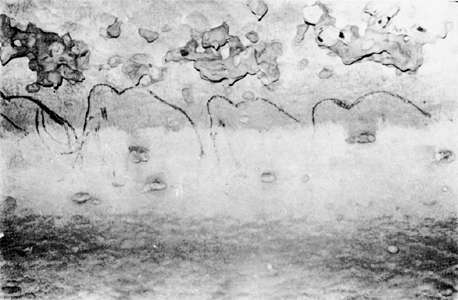
Frieze showing four Mammoths in line, painted in black outline; at the top, there is a strip of protruding flint nodules, which is located near the upper intact part of the figures in the healthy zone, concave, spared by condensation. We see these figures plunge into the whiteness of the condensation zone: protruding from this fog is a foot, one of the tusks, the tail and buttocks of the front Mammoth. This degradation is the case for most of the Mammoth figures closer to the Southwest where the well is located, and cool air descends into the lower parts of the cave - West Gallery.
Photographer: Romain Robert
Photo and (translated) text: Breuil (1959)
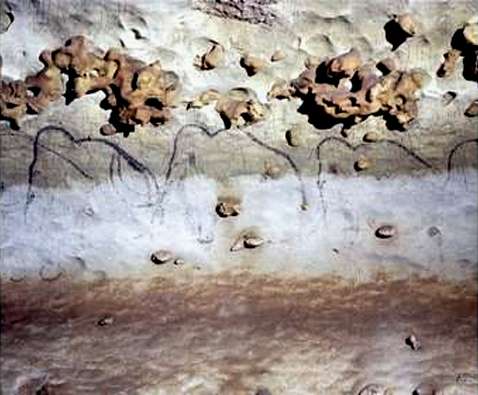
Frieze showing another part of the Mammoths frieze in the photo above. There are apparently eleven mammoths in this frieze.
Photo : http://nicole.rolin.pagesperso-orange.fr/prehistoire/Pages/La%20grotte%20de%20Rouffignac.htm
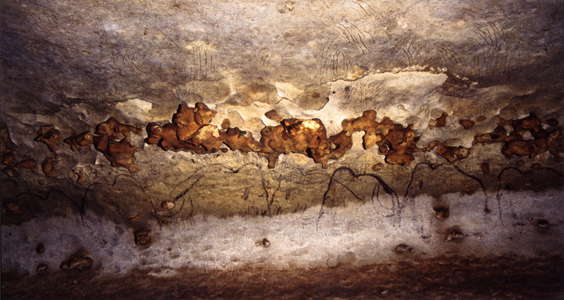
Detail of the mammoths frieze. Two groups of mammoths meet on a slightly protruding section of the wall, between a lower ridge and the band of flint nodules above.
Photo: Marie-Odile and Jean Plassard
Source and text: Desdemaines-Hugon (2010)
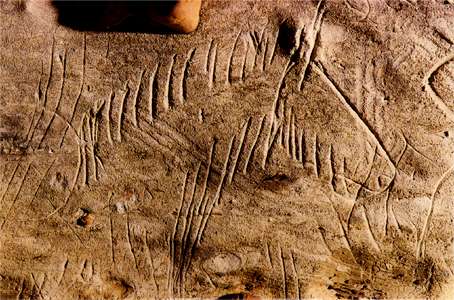
Engraved Horse. This is a masterwork, an engraving apparently on a wall, with superb control by the artist using just a few strokes.
Photo: Postcard © Editions Rene.
Composition of the black pigment used.
Typical values for the underlying rock:
BaO, Barium Oxide: approximately 0.1%
MnO2 approximately 0.1%
Fe2O3 approximately 1%
Typical values for the black pigment, applied at the rate of 4 grams per square metre:
BaO, Barium Oxide: approximately 5% (4% - 15%)
MnO2 approximately 75% (60% - 95%)
Fe2O3 20% (0% - 30%)
Source: Sanoit (2005)
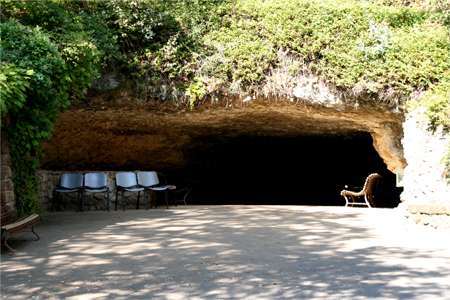
Entry to Rouffignac Cave. (Note that by late September, the waiting lines of people have disappeared! - Don)
Photo:Sémhur, 24 September 2009
Permission: Licence: En tant que détenteur du droit d’auteur, je publie cette œuvre sous la licence suivante :w:fr:Creative Commons
paternité partage à l’identique Ce fichier est sous licence Creative Commons Paternité – Partage des conditions initiales à l’identique 3.0 Unported, 2.5 Générique, 2.0 Générique et 1.0 Générique.
I have been unable to locate images of the two human figures mentioned in
http://www.ksharpe.com/word/AR97.htm
Another supposed human portrayal in Rouffignac Cave depicts ‘Adam and Eve’ (Plassard 1999: 58). Two young children plus an adolescent – who, the flutings suggest, alone as a trio reconnoitered much of the end chambers of the cave (several kilometres) – probably drew these two figures. They also (very poorly) drew tectiforms, animals such as mammoths, and otherwise fluted the walls and ceilings. Perhaps, with as much talent they showed as with their mammoths, the youngsters drew their parents in the image now called ‘Adam and Eve.’ No evidence suggests they were drawing a primordial couple parallel to what the Hebraic biblical tradition calls Adam and Eve.
Reference: Plassard (1999)
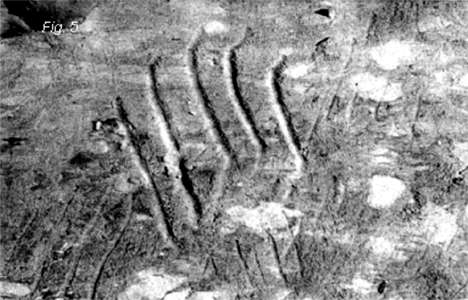
Scratch on the wall left by a cave bear, with an addition by a human finger at the top.
Photo: J. Plassard, Welté et Lambert (2010)
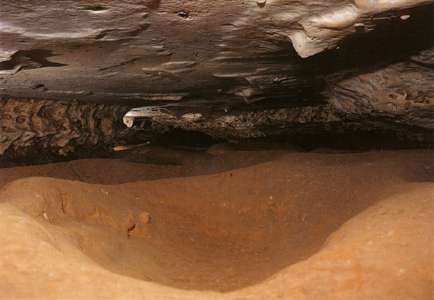
Cave Bear wallow in the dust of the floor of the cave. Many animals make such nests in order to use the dust to rid themselves of parasites.
Photo: Postcard © Editions Rene
Figures inédites de la grotte de Rouffignac
Previously unpublished figures from Rouffignac
Frédéric Plassard et Jean Plassard
In: Gallia préhistoire. Tome 42, 2000. pp. 85-106.
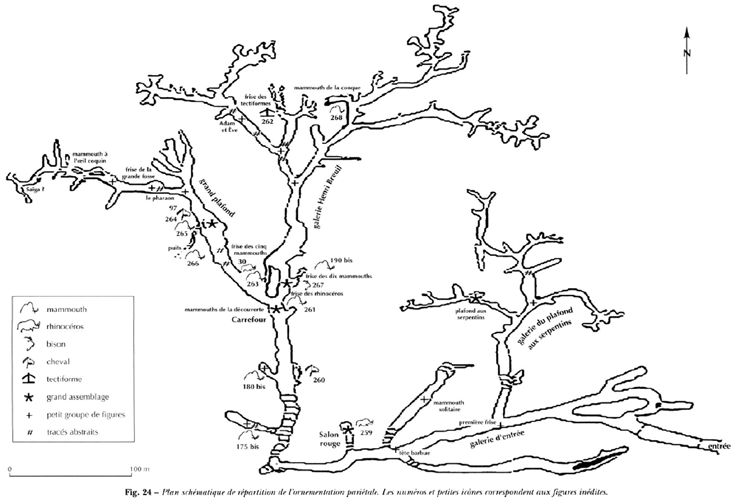
Schematic plan of the ornamentation on the walls. The numbers and small icons correspond to unpublished figures.
(Note that this plan seems to have been laterally stretched compared with other published plans - Don)
Photo: Plassard et Plassard (2000)
Since the discovery of the wall decorations of Rouffignac in 1956, two sets of records have been provided.
The first, published in 1959 by LR Nougier and R. Robert, gave an initial inventory of works of the Great Ceiling and the Breuil Gallery.
The second, published in 1982, is the work of C. Barrier and is an exhaustive treatment of what was then known.
Every census of the decorations of a cave stops at the date of its publication. It is inevitable that more discoveries will be made to add to the original census.
New discoveries have been made, with a not inconsiderable number discovered under recent graffiti, with the original paintings and engravings painfully teased out from the obscuring overlay of modern graffiti.
This process has identified several new paintings and engravings.
The surveying of the Rouffignac figures faces several problems. Firstly, the fragility of the underlying rock prohibits all contact with the figures. Then the relatively large dimensions of the works and the large area of the supporting structures leads to deformations when one tries to photograph the images. Finally it is sometimes difficult to distinguish between natural marks on the wall and the trace of the lines made by the artists.
So the approach had to be varied to best adapt to the imperatives dictated by the topography, the quality of the drawings, the techniques used by the artists, and the dimensions of the images.
Thus the drawings of the rhinoceros 259, the mammoths 175 (two), 180 (two) 261, 265, 268, the bison 267 and the tectiforme 262 are based on photographs which have been checked and corrected on the spot.
In contrast, the horse 260, the mammoth 190 (two) and 266, records were made in situ by preparing a panel of Perspex covered with plastic wrap, and moved as close as possible to the wall without actually touching it. The image was then drawn on the plastic wrap, with the plexiglass used only as a work support.
Finally when the figures already studied by C. Barrière were recorded, his statements served as a basis for their interpretation.
It should also be noted that given the importance attached to the site, certain lines appearing on the photo have been removed from the final image because they are recent in origin.
This is obviously the case with modern inscriptions, but also numerous other marks resulting from sticks or pen knives drawn across the surface, as well as marks traced by fingers were removed.
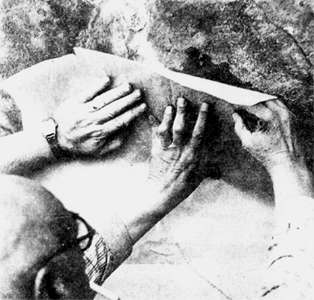
Abbé Henri Breuil tracing a design on a wall with a pencil on translucent paper. This method was recognised even by Breuil himself as not satisfactory in some cases where the underlying wall was soft or likely to be damaged. The method outlined by Plassard et Plassard (2000) here, using perspex and a clear plastic film stretched over it removes this problem almost entirely.
Photo: Aujoulat et al. (2005)
The Panels
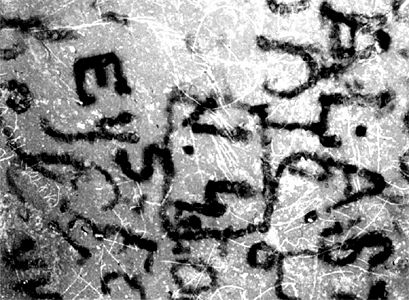
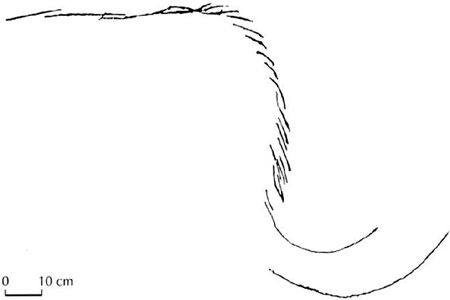
An ancient engraving obscured by soot from burning brands used to make graffiti on the ceiling.
In gallery D, called the Salon Rouge, C. Barrière points out, near Mammoth 173, a series of hatching marks (a series of parallel lines used to create toning or shading) which he interprets as possibly the top of a mammoth's head (left).
It turns out that this figure is more complex, since, to the left, this line of convex hatching is extended by a counter curve, barely concave, evoking the beginning of a dorsal line, while at the other end it plunges vertically approximately 30 cm before recovering in a concave curve rather suggestive of a horn or tusk.
Ten centimetres lower, there appears a second curve parallel to the above but much longer. The absence of a nuchal (back of the neck) groove and a hump above the eye, the non convergence towards the mouth of these apparent tusks as well as the low height of the brow counts against its identification as a mammoth.
Photo: Plassard et Plassard (2000)
The drawing of these two curves as an extension of the front of the drawing, and not, as is customary, starting from further back on the head, the difference in length of the two horns and finally the orientation of hatching on the brow suggesting a shaggy coat, shown this way several times in the cave when depicting rhinoceroses, act against the identification as a mammoth.
This rhinoceros differs from the others in the cave by the treatment of the horns as a single stroke, and not as two lines which is usual, thus depriving them of the sense of volume.
(Note, despite the above, it looks more like a mammoth than a rhinoceros to me. The head of a rhinoceros is commonly drooping down, not held high as in this case, and the interpretation of the horns as those of a rhinoceros drawn as a single line for each I find unconvincing - Don)
Beyond the description of this figure, its integration into the parietal art of the cave system needs little description. Indeed, to date, the Salon Rouge was regarded as a homogenous set of figures, both technically and thematically. This work breaks the thematic unity and increases the complexity of the decoration. Located on the fringes of the principal frieze but between it and two representations of mammoths which complete the decoration of this chamber, it is integrated completely into the ceiling and makes a single and elaborate panel.
However, the technical homogeneity is preserved since the implementation uses the same technique as the other representations of this chamber, that is to say hatching incising the clay coating on the ceiling and exposing the white chalk beneath.
This technical aspect is important because it reinforces the coherence of this panel. Moreover, in the absence of formal proof, it gives credence to the idea that the whole setting of this gallery is the result of an overall design and a probable simultaneous execution of the works.
Mammoth 175 bis
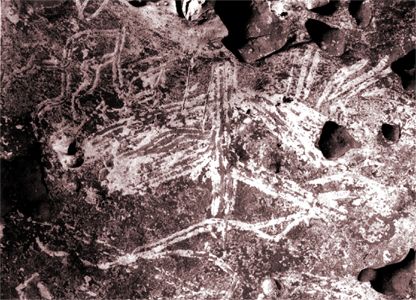
False colour image of the engraving known as Mammoth 175 bis. The original image in black and white may be seen here.
Photo: Plassard et Plassard (2000)
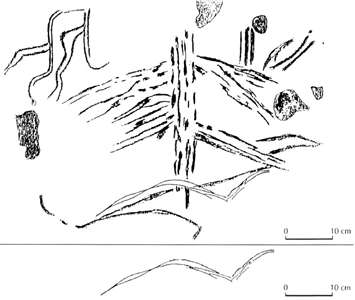
Drawing of the image known as Mammoth 175 bis.
Photo: Plassard et Plassard (2000)
Mammoth 175 bis
This mammoth is in gallery E. After about ten metres, the ceiling falls suddenly in a stepped oblique manner. On the right side of this feature is an abstract set of drawings including the tectiform 175. The latter is superimposed on the schematic engraving of a mammoth.
The medium for the artworks is a wall covered with a coating of clay, which allows etching without special tools.
In this case, the clay surface is less coherent and more powdery than the ceiling of the Salon Rouge. It should also be noted that there is no connection between the macaroni and other tracks made with fingers and the silhouette of the animal which was engraved with burins.
It is this distinction between techniques which led to the identification of this new figure.
The work, in right profile, is of little importance since it measures only 36 cm and is limited to about ten lines showing the top of the head and dorsal ridge as far as the small of the back. The main interest in this drawing lies in its association with tectiforms. Indeed, at Rouffignac, in most cases, tectiforms are near animal representations, but the superposition of tectiforms and representations of animals was not known previously here, while this relationship was already known from other caves like Font de Gaume.
This image therefore reinforces the view that these two caves (as well as Les Combarelles and Bernifal) maintain a relationship with each other.
Mammoth 180 bis
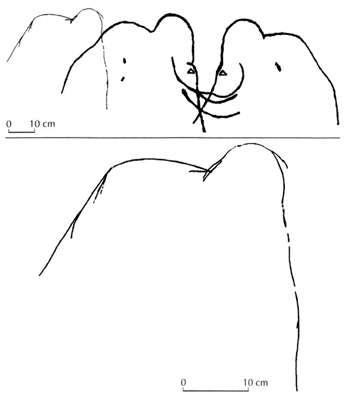
Drawing of the image known as Mammoth 180 bis.
Photo: Plassard et Plassard (2000)
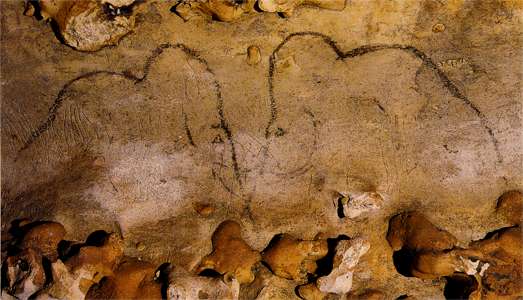
Facing Mammoths, as shown above.
Photo: Postcard © Editions Rene.
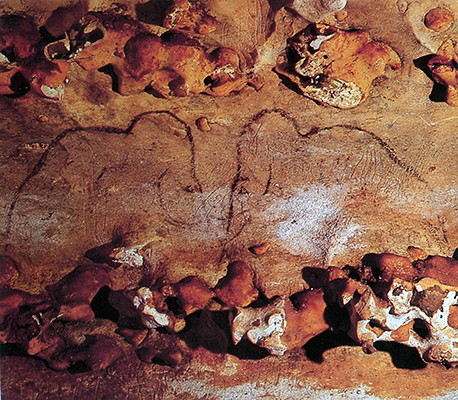
Facing Mammoths.
Photo: Leroi-Gourhan (1984)
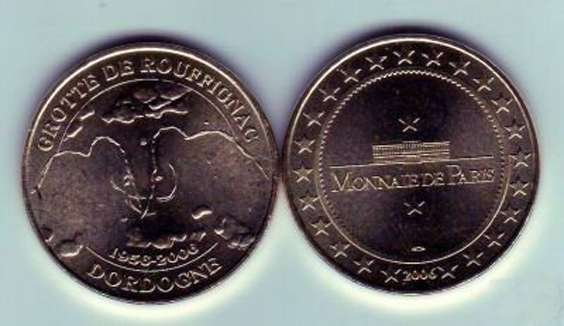
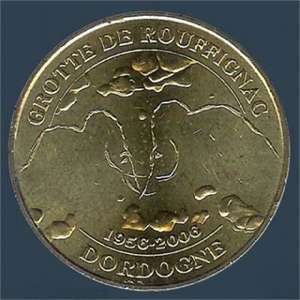
The mammoths have been commemorated on a coin.
Photo: http://www.snowcave.ru/mcrgo/projects/collection/coins.htm
This engraving is in gallery G3. It is a very obvious silhouette that C. Barrière must necessarily have seen, but failed to include in his monograph.
Located on the right wall, this set involves three mammoths. Two have been already published ( Barrière, 1982) and are depicted face-to-face; the back of the one treated in right profile intersects, above the bulge of the brow, the shape of the mammoth 180 bis.
Drawn on chalk hardened by a thin layer of calcite, it was drawn with a very sharp flint tool, producing a line whose thickness and depth are 0.2 to 0.3 mm.
Because the shallow penetration of the tool into the rock beneath prohibited continuity of gesture, the line is divided into fourteen segments. The result is nevertheless excellent and the subject is in all other respects identical to its two companions.
Cheval 260
Among the unpublished figures, the most interesting is without doubt this engraving of the head and shoulders of a horse.
At 583 metres from the entrance, a large sinkhole near a drawing of a mammoth opens on the right edge of Gallery G.
A 50 cm wide crack in the rock opens at the bottom of this cavity. The work is situated about ten metres from the entrance to this narrow passage.
It consists of the right profile of a horse, 52 cm long and 32 cm high. It is drawn on the right wall in the narrowest part of the passage, only 48 cm wide at this location.
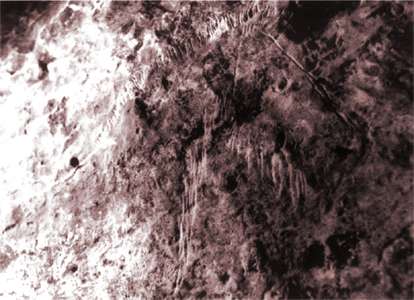
False colour image of the engraving known as Cheval 260. The original image in black and white may be seen here.
The oblique angle of view of the photograph here, necessary because of the 48 cm wide passage the horse has been created in, translates as a distortion in the proportions of the head and neck. These distortions disappear once the drawing/tracing on a transparent medium has been made.
As referred to previously, a transparent piece of perspex covered with plastic film was placed in front of those images which were either too large or too difficult of access (as in this case) to obtain a true representation by ordinary photography. The image was then traced onto the transparent film, which was then brought out into a suitable area for an accurate, distortion free copy to be made.
Photo: Plassard et Plassard (2000)
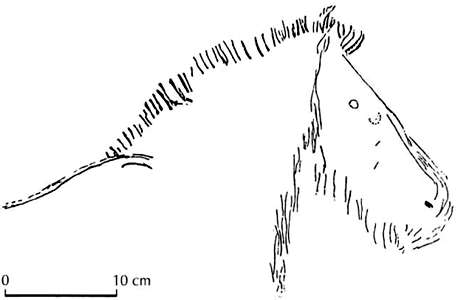
Drawing of Cheval 260, done on plastic film over a clear Perspex sheet.
Photo: Plassard et Plassard (2000)
The wall at that point is relatively hard, and presents a surface which consists of an ensemble of shallow wells. The artist had freedom to choose any medium for his work, and chose to use engraving.
The depiction of the animal is limited to the head, the chest, the mane and half the dorsal line. The continuity of the line representing the ear, jaw and breast, the treatment of the lower jaw, and the indication of a forelock makes a face that fits perfectly into the stylistic conventions of the site.
Yet, despite these restrictions, this work is remarkable for several original techniques. This is particularly true of the mane in which there is an irregular 'rhythm.' It is composed of five groups of hatch marks, with one for the forelock. Each group is characterised by its own profile of characteristics and dissociates itself from its neighbours by a shift in height. It is plausible that this fractionation results from the inability to stand facing the work, the artist then being positioned obliquely to his subject was forced to move several times during the progress of his work. This resulted in changes in the position of his hand against the wall, which changed the angle of the tool, causing the the five different profile features.
Perhaps it is also the reason for the set of graphics governing the location of the eye. Without human intervention, a cupule or a shell could replace the eye. According to the observation point, forward or rear, each of these natural features can play this role in succession. Note however that it is now impossible to say that the artist deliberately kept this ambiguity.
The ultimate originality of this discovery lies in its location. The horse was hitherto at Rouffignac regarded as restricted to certain areas only, namely the Breuil gallery, where only two horses are known, the Grand ceiling, which contains a dozen horses, and the well of the Grand ceiling where we know of only one representation of a horse. The representation which interests us here, by its marginal position, leads us to admit that the disposition of parietal art is more complex than was previously considered the case.
Mammoth 261
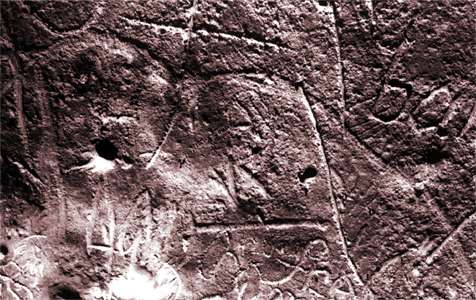
False colour image of the engraving known as Mammoth 261. The original image in black and white may be seen here.
Photo: Plassard et Plassard (2000)
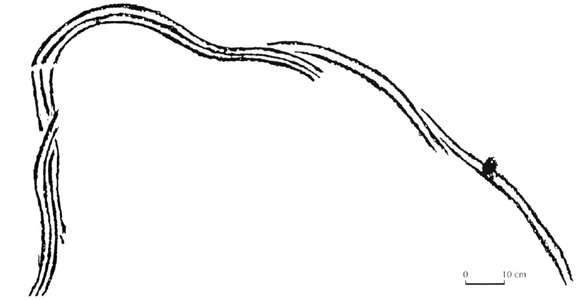
Drawing of Mammoth 261.
Although drawn with the fingers only, the line is deeply inscribed in the chalk powder of the ceiling, and the image features Palaeolithic traits easily distinguished from the other historical age marks (graffiti) on the surface.
Photo: Plassard et Plassard (2000)
This mammoth is at the beginning of the Breuil gallery on the left edge of the ceiling. Like several other figures on the ceiling of this part of the cave, this figure is relatively high: 1.44 m. This is a figure constructed by finger marks in five movements. The first step involves the evocation of the crown of the head and the nape. From there, one line traces the forehead while the second shows the orbital bulge and the trunk bent slightly forward.
The dorsal line of the back is also made in two strokes, the first of the backbone while the second represents the rump and the beginning of the tail. Note that while at the front of the figure three fingers were used, only two were used to the rear.
The discovery of this figure throws a new light on the construction of the decorations in this part of the cave. We shall return later to this new figure. Indeed, on the one hand, by its location, the figure shows that contrary to an old idea, one is not able to consider the Breuil Gallery as two long walls each supporting a string of two dozen art works, and on the other hand, by its position, this image has left to the bear nearby on the wall its role as the main representative of this grand assemblage, which alters the interpretation made by A. Leroi-Gourhan.
Bison 267
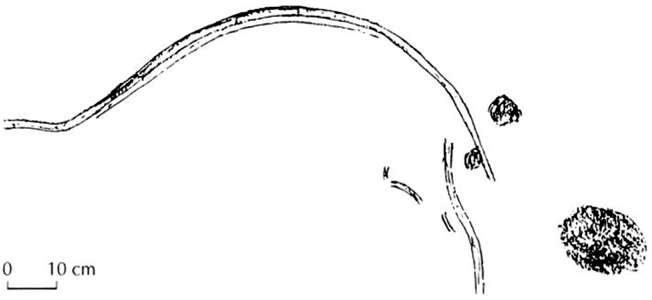
Drawing of Bison 267. Note the obtuse angle on the left formed by the rear of the hump and the start of the back.
(this obtuse angle thus being quite different to the narrow V of the nuchal, nape, or neck angle of a mammoth - Don)
Photo: Plassard et Plassard (2000)
This bison is located on the right wall of the Breuil Gallery. The decoration of this area begins with the frieze of three rhinos, immediately followed by three engraved mammoth silhouettes.
The decor is then interrupted 1.70m further on by the appearance of a very clear arc of a circle. Such a line should not go unnoticed. It was, however, routinely neglected until now. We have therefore decided to use this forum to publish the discovery. During the process of the study of this image, we realised that this a more elaborate ensemble than it appears.
Indeed, it appears that the curve is extended to the left by a horizontal segment of 12 cm referring to the beginning of a dorsal line. Furthermore, at the other end, a line less heavily drawn, an 's' shaped counter-curve, descends vertically by thirty centimetres, forming a frontal line.
Finally, a few centimetres to the rear of this frontal line, there are three short segments whose location corresponds to the location of a horn. The entire drawing has been made by fingers. The arc forming the top of the skull is strengthened and doubled along two thirds of its length, while the frontal line and the three small neighbouring segments are only barely indicated.
The attribution of the image to a Bison may seem subjective, however, several arguments lead us to this conclusion. The first of these is the absence of a nuchal (back of the neck) groove which is so characteristic of mammoths. The second aspect is the relatively low profile of the arc forming the neck. The third is the presence of three short segments located at the rear of the forehead; their location corresponds to the point of implantation of a buffalo horn. We will see later that the presence of bison in this area is in compliance with the disposition of the parietal art of the cave.
Mammoth 190
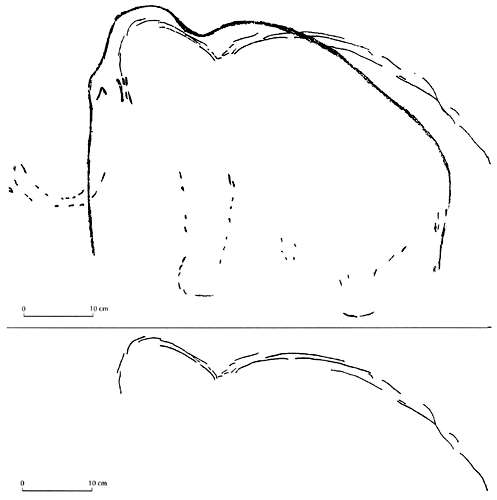
Mammoths 190 et 190 bis. At the top, the two subjects superimposed, at the bottom, mammoth 190 bis alone.
Photo: Plassard et Plassard (2000)
In left profile, the mammoth 190 bis is in a frieze of ten, the last of the herd on the right. The figure is limited to the depiction of the top of the head and the back. Like the mammoth 180 bis previously discussed, we are dealing with an outline on a hard wall engraved with a cutting tool having produced a line consisting of many chips, each a few tenths of a millimetre in size.
The engraving is to some extent overdrawn by another work. However, it should be noted that, in this case, the two subjects are barely shifted laterally and vertically from each other.
The great similarity of the base or medium, the resemblance of the tools used and the identical movements of the tools suggest that we are, in this case as in the other, observing an answer to a technical problem.
In addition, careful observation of other animals in the frieze has not resulted in the identification of any other figures of this type. We do not consider that this figure is merely a preliminary sketch.
On the other hand reading this panel for understanding is less complicated than for the mammoth 180 bis because this engraving does not add to or subtract from the rest of the frieze.
It seems that the hypothesis of simple abandonment of one technique in favour of another can be accepted.
Before concluding this section, we wish to emphasise that certain additions, at the trunk and legs, were made to record the mammoth 190, in order to correct damage by modern graffiti in order to allow a better reading of this work.
Tectiforme 262
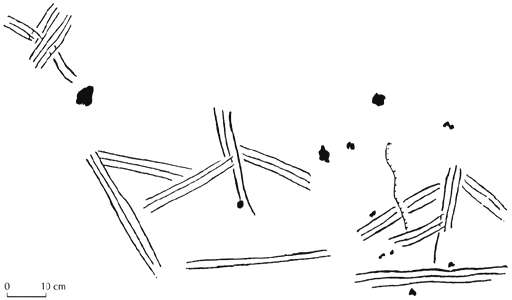
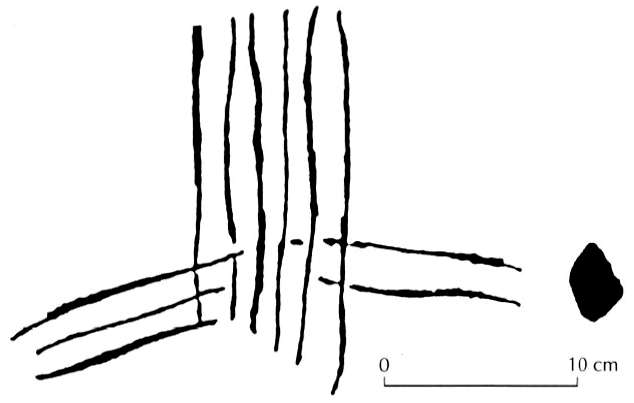
Tectiforme 262 in situ (left) and alone (right).
Photo: Plassard et Plassard (2000)
This is the 14th tectiform of the cave, discovered in company with A. and D. Vialou.
Except for the Mammoth 175 superimposed on the mammoth tectiforms 175 bis described above, the tectiforms of Rouffignac are all very individualised. Some are accompanying one or more animal figures while others are relatively isolated.
In this case, the representation is part of what one might almost name the 'frieze of three tectiforms' since it is associated with tectiforms 246 and 247.
This ensemble forms the last panel of the gallery H1. This unpublished tectiform is the first and smallest of the group. Despite its schematics, it fits perfectly within the framework of a group which we consider to be 'plumed' tectiforms. Indeed, amongst the characteristics of the tectiforms of this cave, this is a feature already recognised for eight of these signs, which is the marked prolongation of the 'mast' above the figure.
Some of these extensions are even accentuated by a repetition, as is the case with this 9th example of the series and is a strong argument for attributing this work to the category of tectiforms.
Mammoth 268
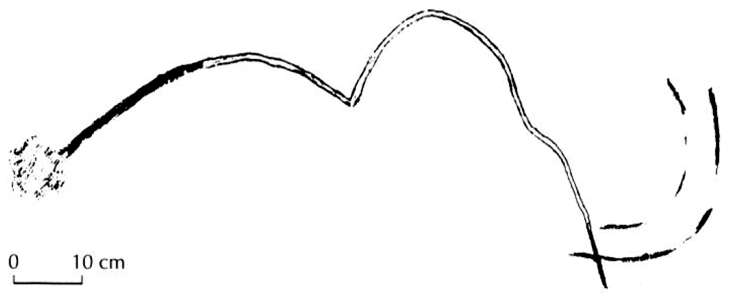
Mammoth 268.
Here we can see that some lines are drawn as grooves by the finger in softer material, while others are drawn as solid clay lines with the excess material built up on the tip of the finger when harder surfaces are encountered. This is explained in the text below.
Photo: Plassard et Plassard (2000)
This figure is located on the edge of the gallery I, at the crossroads of two lower galleries. The gallery to the right contains mammoths 252 and 253 which are the last graphical manifestations in this part of the cave. The mammoth 268 is located three metres further on, on the ceiling. At this point, the ceiling is 150 cm high, and is pierced by a dome of about one metre in diameter. It is in this dome that the artist has put his work.
It consists of a finger drawing showing a silhouette and two tusks, the whole measuring 80 cm across.
Four strokes were sufficient to complete the figure. Starting at the bottom of the neck groove, a line is drawn to show the head and the trunk, while another represents the dorsal line, stopping at the start of the tail. The remaining two lines show the two tusks.
Despite this simplicity, which is customary with the Rouffignac artists, the work is well made; one can note the head held high, the bone of the supraorbital ridge above the eye is well marked, and the tusks are in proportion.
It is rather the structure of the lines of this work that is unexpected. Indeed, at this point, the presence of glauconite in the sediment leads to small sections of the surface being soft, succeeded by harder zones.
(Glauconite is an iron potassium phyllosilicate (mica group) mineral of characteristic green colour with very low weathering resistance and very friable. Its name is derived from the Greek "glaucos" meaning 'gleaming' or 'silvery', to describe the shining appearance of the blue-green color. Its colour ranges from olive green, blackish green, to bluish green. - Don, from Wikipedia)
This discontinuity in the softness of the surface has caused irregularities in the trace left by the finger of the artist.
Where the surface was soft with glauconite, the finger has dug a relatively deep groove in the surface, while the excess clay was accumulating at the end of the finger.
When the surface became hard, the material gathered in the previous section was deposited as a drawn line. Thus the back, head, and almost all of the trunk are relatively deeply etched, while the rump, the end of the trunk and the tusks are drawn with the excess clay.
Mammoth 263
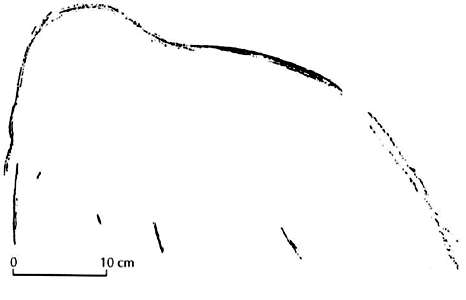
Mammoth 263.
Although schematic, it retains the bump of the bone over the eye, (the orbital hump), and the marked downward gradient of the dorsal line from front to back, typical of mammoths.
Photo: Plassard et Plassard (2000)
Measuring 50 cm, this drawing of a mammoth is the first work on the right wall of the gallery called the Sacred Way. It has been made by a finger, but it is beautifully executed. Eight actions can be distinguished in the construction of this left profile of the mammoth.
Two are used for the top of the head and the start of the trunk, while two others finish the dorsal ridge.
The last four, of which we can see only small traces, suggest the hair of the belly and the start of the trunk.
Despite its isolation on the right wall, this representation is part of a small group of mammoths, since, about five metres away are two large silhouettes (M26 and M27) respectively occupying the left and right edges of the ceiling while almost opposite, on the left wall, one sees a fourth mammoth (M28).
Rhinoceros 30
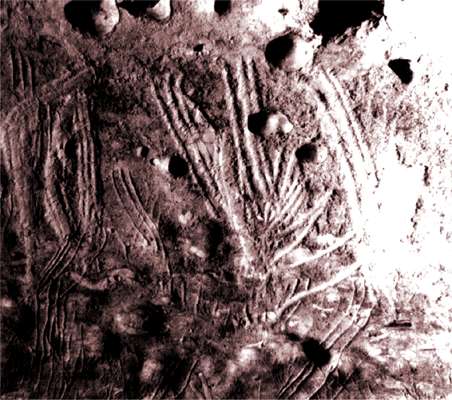
False colour image of the engraving known as Rhinoceros 30.
The original image in black and white may be seen here.
Photo: Plassard et Plassard (2000)
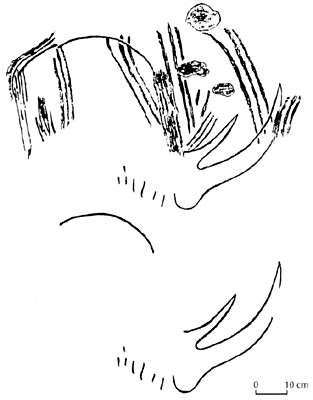
Drawing of the engraving known as Rhinoceros 30.
(above) The original engraving.
(below) The drawing with extraneous lines removed.
Photo: Plassard et Plassard (2000)
Rhinoceros 30 is located on the right wall about twenty metres from the entrance to the Sacred Way.
Barrière (1982) limits this engraving to two horns and the start of the muzzle. Looking at a less oblique angle of lighting allows us to identify the representation of the head with the beginning of the back, with the throat below the head and jaw represented by a set of six short strokes.
Horse 97 - Cheval 97
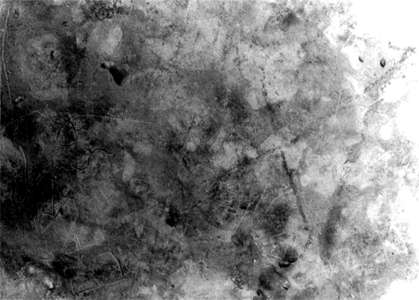
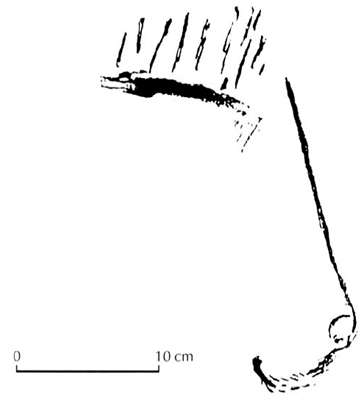
Although the entire interior of the head has been shaded by the remains of soot from the firebrands of earlier visitors, this has been mitigated by the intervention of later rehabilitation.
Note in the photo on the left the difference in appearance of the lines drawn with manganese dioxide by the original artist and the traces of soot from historical visitors.
Fortunately, the combination of a careful study of the photo and the actual painting in situ has allowed the complete restoration of the original design in the drawing on the right.
Photo: Plassard et Plassard (2000)
At the end of his monograph on the Grand Plafond, the Grand Ceiling, Barrière (1980) reported in the centre of the Grand Ceiling the figure of an incomplete horse with a muzzle and nostrils.
Careful work in cleaning graffiti from the masterwork of the Grand Plafond led to the discovery of features complementing this figure.
There are seven features in the figure, making up the subhorizontal top of the neck and the vertical mane, as well as an indication of the muzzle. The hypothesis of a horse's head in right profile is therefore confirmed.
The work measures 225 mm from the nostril to the top of the mane.
Horse 264 and Mammoth 89
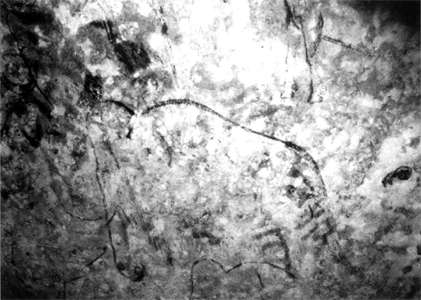
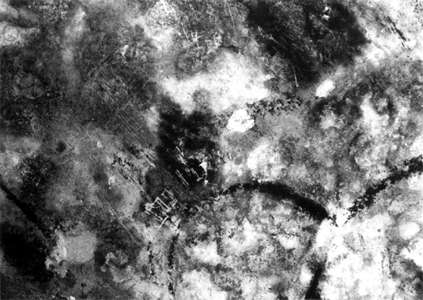
Horse 264 (very much obscured) and Mammoth 89.
Photo: Plassard et Plassard (2000)
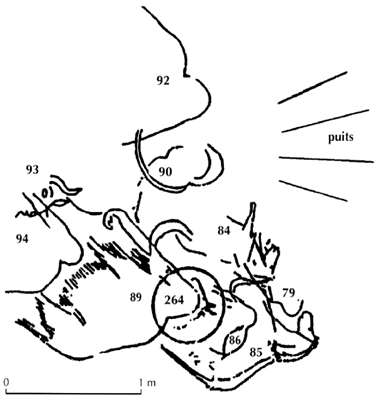
Horse 264 in position above Mammoth 89 on the Grand Plafond.
Photo: Plassard et Plassard (2000)
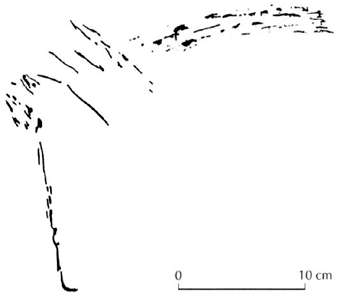
Drawing of Horse 264.
Photo: Plassard et Plassard (2000)
The inner lines of the forehead and mane of Horse 264 frames the top of the skull of the mammoth 89 (Fig. 15 to 18). Much altered, this left profile of a horse is now only minimally represented.
As in the case of Horse 97, the drawing is limited to the representation of the forehead, the ear, the beginnings of the mane and the top line of the neck. Measuring only 16 cm from the nostril to the tip of the ear, it is by reason of these small dimensions that this head stands out from its neighbours.
Mammoth 265
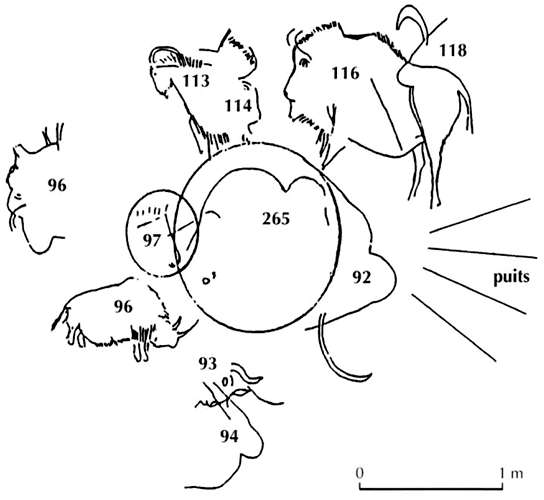
Position of Mammoth 265 on the Grand Plafond.
Photo: Plassard et Plassard (2000)
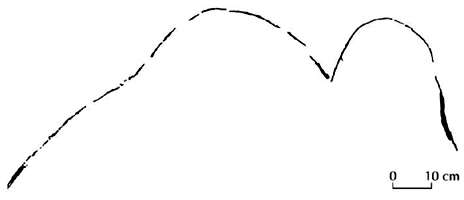
Mammoth 265 on the Grand Plafond. It has been almost completely worn away by visitors rubbing their backs on the low ceiling in the past, and it can only be recognised and redrawn in situ.
Photo: Plassard et Plassard (2000)
The rediscovery of this mammoth is another result of the rehabilitation of the Grand Plafond. This figure is in the area that was most affected by graffiti and smudging by the backs of visitors rubbing against the low ceiling in times past. It was the elimination of sooty smudges that allowed us to read this silhouette. Only the sloping back, the well defined head held very high and the bump of the bone above the orbit of the eye are today visible. This work is in right profile, and may have been more detailed than it seems at present, or perhaps was, like many others in this section, limited to a simple sketch.
Mammoth 266
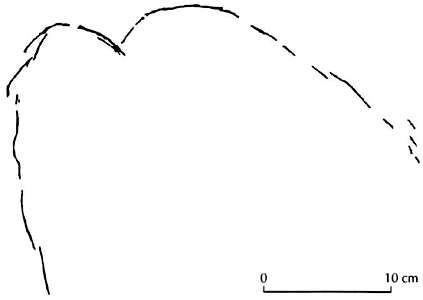
Sketch of Mammoth 266. As for Mammoth 265, it is on the edge of the Grand Plafond, and has suffered from the rubbing by the backs of previous visitors, and is only able to be seen clearly in situ.
Photo: Plassard et Plassard (2000)
Mammoth 266 is the 13th representation of the well. It has been very finely engraved, which explains why it was not noticed until recently. In addition, its location makes it difficult to discern, since it has been traced on each side of a rocky ridge. Located immediately below the human face, it is in left profile. The head is on one side of the ridge of rock, and the back on the other. This also obliterates the hump of one of the bisons.
Tectiforms at Rouffignac
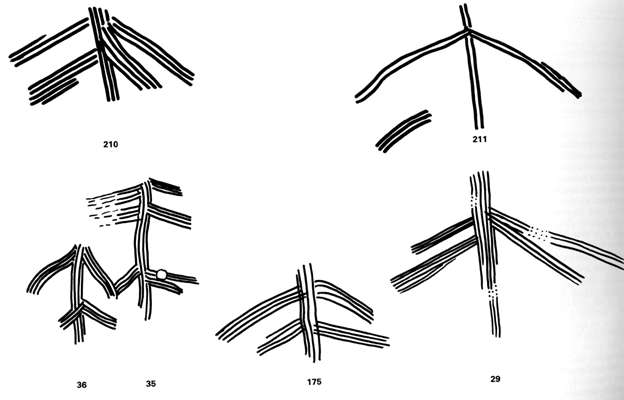
Tectiforms at Rouffignac - these forms are sometimes likened to a fir tree, or a Christmas tree.
Photo: http://nicole.rolin.pagesperso-orange.fr/prehistoire/Pages/La%20grotte%20de%20Rouffignac.htm
The Friezes around the crossroads
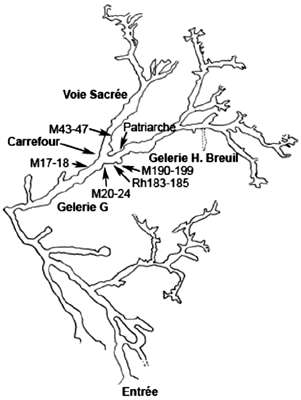
Plan of the region around the crossroads, with the relevant artworks noted.
Photo: Igarashi (2010)

Panel of mammoths 20-24 in the Grotte de Rouffignac. M20 (L = 110 cm), M21
(L = 105 cm) et M22 (L = 72 cm). (Photo Jean Plassard.)
Photo: Igarashi (2010)
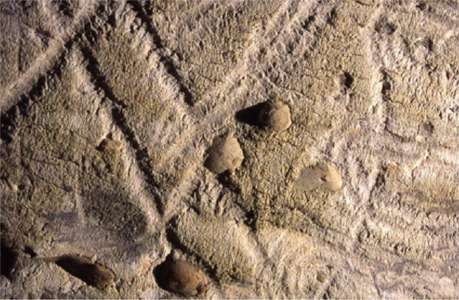
Detail of Mammoths 20 - 21 from the photo above. A pair of parallel oblique lines has been obliterated by the midline of mammoth 21 and a V-sign traced by three fingers, a serpentine figure which obliterates the upper tusk of Mammoth 20, and which is itself obliterated by a pair of slashes.
Photo: Jannu Igarashi, Igarashi (2010)

Left side of the frieze of the 5 mammoths of the Sacred Way. M43 (L = 85 cm), M44 (L = 85 cm) and M45 (L = 45 cm).
Photo: Jean Plassard, Igarashi (2010)
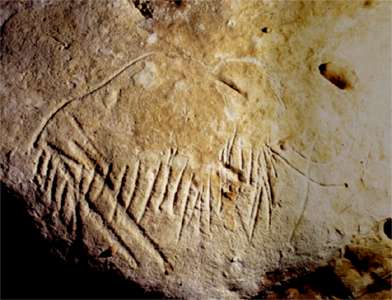
Mammoth 158 with slash marks through the rump (L = 70 cm).
Photo: Jean Plassard, Igarashi (2010)
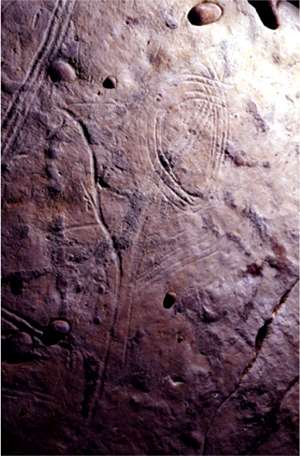
Mammoth 145 (the front of the face and the eye, H = 80 cm).
Two representations of the mammoth having only the front of the face and the eye have been identified:
mammoths 144 and 145.
It would appear that the artist began the work, but did not finish it.
Photo: Jean Plassard, Igarashi (2010)
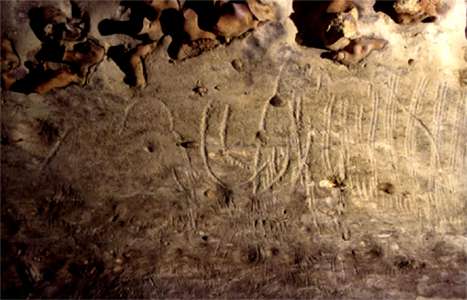
Mammoths M17 and M18.
M18 - Length = 85cm.
Photo: Jean Plassard, Igarashi (2010)
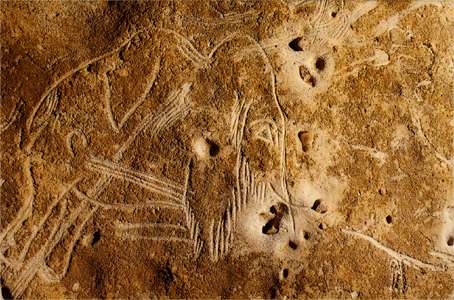
Large engraved mammoth. Note the well defined eye in the shape of a triangle.
Photo: Postcard © Editions Rene.
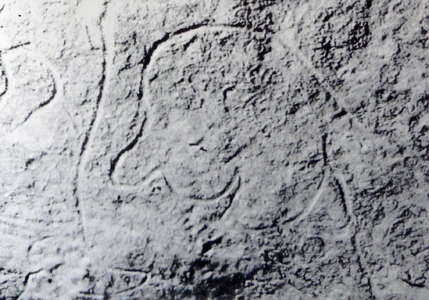
Human image engraved on the wall at Rouffignac.
Photo: Leroi-Gourhan (1973)
Table: A comparison of the friezes around the "crossroads"
| Panel | Mammoths 17 - 18 | Mammoths 20 - 24 | Frieze of 5 Mammoths | Frieze of 3 Rhinoceros | Frieze of 10 Mammoths | Patriarch |
|---|---|---|---|---|---|---|
| Placement | Gallery G | Sacred Way | H. Breuil Gallery | |||
| Identification | M17 - 18 | M20 - 24 | M43 - 47 | Rh183 - 185 | M190 - 199 | Bear200 - M221 |
| Technique | Engraving with a tool and/or finger(s) | Engraving with a tool and/or finger(s) | Engraving with a tool and/or finger(s) | Black Drawing | Black drawing | Engraving with a tool and/or finger(s) |
| Animal Figures | Mammoths | Mammoths | Mammoths | Rhinoceros | Mammoths | Mammoths, Horses, Bison, Rhinoceros |
| Signs | Linear Signs | Linear and Complex Signs | Linear and Complex Signs | Linear Signs | None | Linear and Complex Signs |
| Arrangement | Superimposed | Superimposed | Superimposed | Enough Space | Well arranged | Superimposed |
Finger Flutings at Rouffignac Cave
Dr Van Gelder has developed methods of determining age, sex, and even individuals based on finger flutings.
10 Years in Rouffignac: A Collective Report on Findings from a Decade of Finger Flutings Research
Van Gelder (2010)
Plassard (1999) records approximately 500 square metres of finger flutings in Rouffignac Cave, nearly all of which are in excellent condition as they do not have calcite covering them as is the case in some other caves.Studies were conducted from 2002-2004 in cross-cultural, cross-age groups to determine if there were any significant differences in the three fingered measured width with regard to age of individuals. Results showed that though there were no significant differences in measures of adults and adolescents across cultures, there was a significant difference in the measure of a child's hand as opposed to an adult's. No adult/adolescent hands were recorded at a measure of 30 mm or smaller and very few were recorded below 34 mm. Experiments with young children suggested that children at age 3 were able to have the motor control to do small stream flutings, however by age 5 they were capable of far more significant capacity to create and sustain the drawing of longer and more complex lines.
In the finer tuning of a method to determine individuals through flutings, when the fingers are designated as F2 (index), F3 (middle), F4 (fourth), the research points to findings showing that F2/F4 < 1 suggests a male and F2/F4 ≥ 1 suggests a female.
Early references to finger flutings in archaeological literature used often meaning-laden language which the researchers found impeded a clear understanding of the flutings themselves. The literature referred to them as 'serpentines', 'meanders', 'macaroni' and 'water signs'.
A working vocabulary was established and has been used consistently throughout the work in the hope that it would become the standard language for the discussion of flutings.
As such, a fluter makes a fluting by sweeping his or her fingers across a soft surface;
a unit comprises flutings drawn with one sweep of one hand or finger;
the profile of a unit or a fluter comprises the silhouette of the finger tops left in the medium from the fluting;
a cluster comprises an isolatable group of units that exhibit a unity, for instance because they overlay each other;
and a panel comprises a collection of clusters that appears geographically or otherwise distant from other clusters or on a surface of reasonably uniform orientation
Four forms of flutings were named based on whether or not the fluter used one finger or multiple fingers, and whether or not the fluting was the product of lower body motion or standing still. Names which had no conventional meanings were chosen purposefully to remove the past tradition of using meaning-laden language for description.
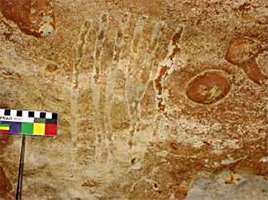
Thus, Kirian lines describe lines made with a single finger and no lower body movement.
Photo: Van Gelder (2010)
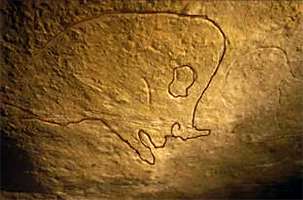
Evelynian lines describe lines made with a single finger and show lower body movement. These are very often large figurative images such as 'Adam' shown here.
Photo: Van Gelder (2010)
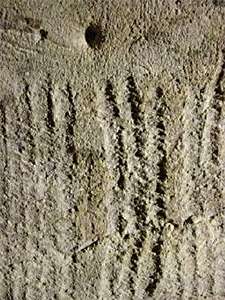
Rugolean lines describe lines made with multiple fingers and no lower body movement.
Photo: Van Gelder (2010)
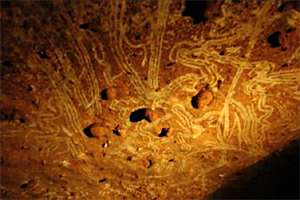
Mirian lines describe lines made with multiple fingers and show lower body movement.
Photo: Van Gelder (2010)
All four forms appear in Rouffignac Cave. Based on the current understandings and assumptions within Rouffignac, the data suggests that the cave was fluted by at least seven individuals who have been identified. Current work looks not only to identify each of the individuals but to examine the locations in which they occur in the cave, relationships among the fluters in terms of which fluters are found in close proximity to others so as to create a clearer picture of who they are in relation to each other.
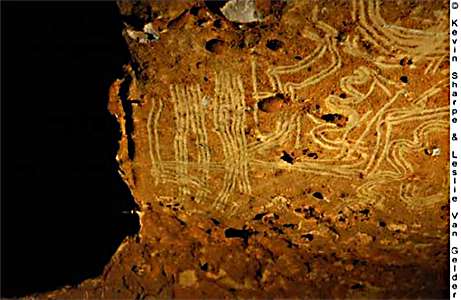
Finger flutings at the start of the Desbordes panel in chamber A1.
Photo: Sharpe et Van Gelder
Permission: GNU Free Documentation License, Version 1.2
This is a wonderful resource, a video of a visit to the cave on 11/08/1956 by Abbé Breuil, Professor Graziosi, Director of the Museum of Anthropology of Florence, and the owners of the site.
Here we see the visitors preparing to enter the cave, carrying carbide/acetylene torches for lighting.
Abbé Breuil is on the right of these two photos in his characteristic beret.
Still of video from:
http://www.ina.fr/histoire-et-conflits/epoques/video/CAF97060411/visite-de-la-grotte-rouffignac-fouilles-en-galilee.fr.html
Even at this time, the entry was very wide and high enough to enter without stooping.
It is remarkable that a good video could be made under such difficult lighting conditions at such a time, more than fifty years ago.
Still of video from:
http://www.ina.fr/histoire-et-conflits/epoques/video/CAF97060411/visite-de-la-grotte-rouffignac-fouilles-en-galilee.fr.html
It was a considerable distance in before this engraving of a mammoth, and a drawing of a wooly rhinoceros could be observed and filmed. Visitors now use an electric train.
Still of video from:
http://www.ina.fr/histoire-et-conflits/epoques/video/CAF97060411/visite-de-la-grotte-rouffignac-fouilles-en-galilee.fr.html
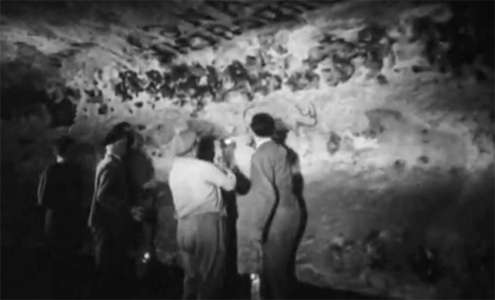
This still gives a good idea of the scale of the paintings, and the characteristic nodules in the walls.
Still of video from:
http://www.ina.fr/histoire-et-conflits/epoques/video/CAF97060411/visite-de-la-grotte-rouffignac-fouilles-en-galilee.fr.html
At this point a magnesium flare was lit to give better lighting for the film.
Still of video from:
http://www.ina.fr/histoire-et-conflits/epoques/video/CAF97060411/visite-de-la-grotte-rouffignac-fouilles-en-galilee.fr.html
The attraction of the cave for palaeolithic hunters was not only for the opportunity to draw on its walls. The local limestone is full of good quality flint nodules for making tools. These photographs were taken just outside the main entrance.
Photo: Don Hitchcock 2008
References
- Aujoulat N., Perazio G., Faverge D., Peral F., 2005: Contribution de la saisie tridimensionnelle à l'étude de l'art pariétal et de son contexte physique, Bulletin de la Société préhistorique française. 2005, tome 102, N. 1. pp. 189-197.
- Barrière, C., et Sahly, A., 1964: Les empreintes humaines de Lascaux. Miscelanea en Homenaje al Abate Henri Breuil, t. I, PP. 173-180, Barcelone, 1964, Diputacion Prov. de Barcelona, Inst. Prehist., y Arqueologia
- Barrière, C., 1980: Le Grand Plafond de Rouffignac, Bulletin de la Société préhistorique française. 1980, tome 77, No.9. pp. 269-276
- Barrière, C., 1982: L'art pariétal de Rouffignac, Paris, Picard, Fondation Singer-Polignac, 208 p.
- Breuil, H., 1959: Des preuves de l'authenticité des figures pariétales de la Caverne de Rouffignac, Bulletin de la Société préhistorique française. 1959, tome 56, N. 1-2. pp. 82-92.
- Desdemaines-Hugon C. , 2010: Stepping Stones, Yale
- Glory, A., 1955: La caverne ornée de Bara-Bahau, l'an 40000 naissait l'Art, Le Bugue, 20 p.
- Igarashi, J., 2010: Chronologie de la réalisation d'une frise de mammouths dans la grotte de Rouffignac (Dordogne, France), Congrès de l’IFRAO, septembre 2010 – Symposium : L’art pléistocène en Europe (Pré-Actes)
- Leroi-Gourhan A., 1973: Prähistorische Kunst: d. Ursprünge d. Kunst in Europa, Herder, 1973 - 601 pages
- Leroi-Gourhan A., 1984: L'Art des cavernes : Atlas des grottes ornées paléolithiques françaises, Relié – 1 décembre 1984
- Plassard, J., 1999: Rouffignac : Le sanctuaire des mammouths, Paris: Seuil.
- Plassard F, Plassard J., 2000: Figures inédites de la grotte de Rouffignac, Gallia préhistoire. Tome 42, 2000. pp. 85-106.
- Sanoit J., Chambellan D., Plassard F., 2005: La fluorescence X fait parler les mammouths de Rouffignac Séminaire MESUREXPO 27 septembre 2005
- Sieveking, A., 1979: The Cave Artists, Thames and Hudson
- Van Gelder L., 2010: 10 Years in Rouffignac: A Collective Report on Findings from a Decade of Finger Flutings Research, Congrès de l’IFRAO, septembre 2010 – Symposium : L’art pléistocène en Europe (Pré-Actes) IFRAO Congress, September 2010 – Symposium: Pleistocene art in Europe (Pre-Acts)
- Welté A.-C. et LAMBERT G., 2010: Mythes et Symboles dans les manifestations artistiques du Paléolithique supérieur : la place des assemblages animal/animal et animal/humain Congrès de l’IFRAO. Septembre 2010 – Symposium : Signes, symboles, mythes et idéologie… (Pré-Actes)
Back to Don's Maps
 Back to Archaeological Sites
Back to Archaeological Sites
